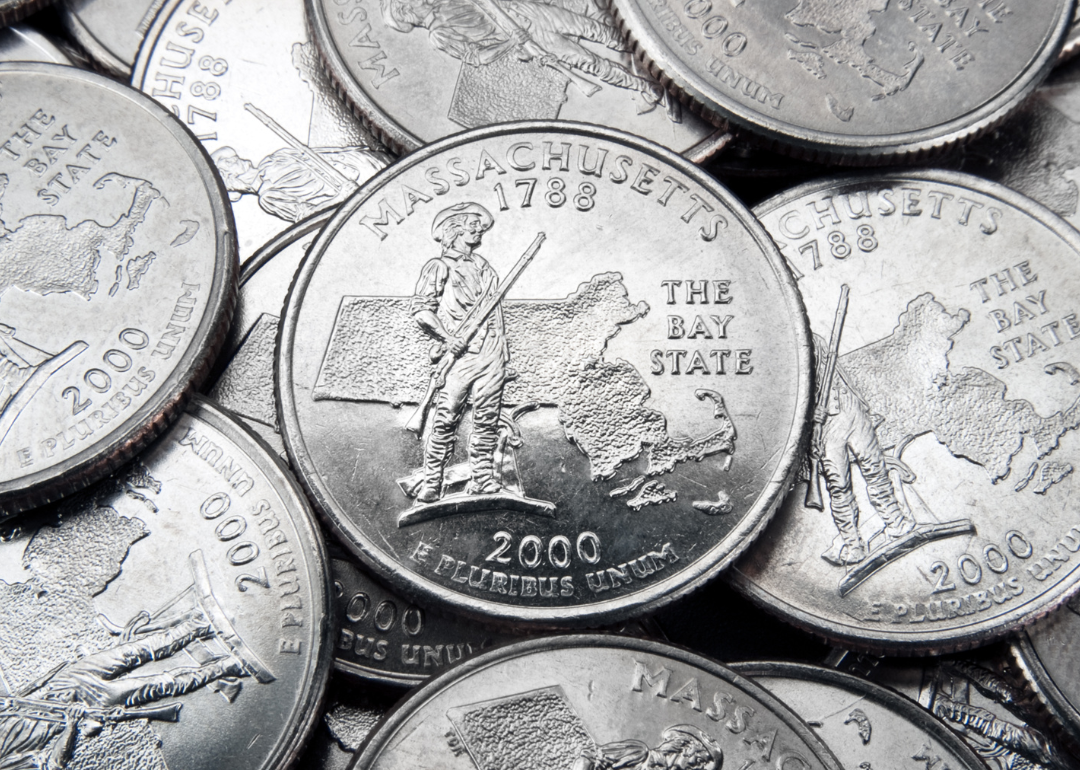
Do you know the story behind your state quarter?
From 1999 through 2008, five new quarters were released each year celebrating the heritage of each state in the order that they ratified the Constitution or were admitted into the Union.
More than 34 billion quarters were minted during this 10-year period, which 147 million Americans collected. The program earned about $3 billion from increased quarter demand. It was the most successful coin initiative in U.S. history. Each quarter was minted for up to 10 weeks, and was never produced again. Beyond the distinctive symbols for each state, the back of the quarter also showed the year the state became part of the union, the year the quarter was created, and "E Pluribus Unum." The front of the quarter continued to show the same image of George Washington.
The program represented the first change to the quarter since production of the Bicentennial Quarter in 1975 and 1976. Kermit the Frog even served as the official "spokesfrog" for the 10-year program.
But how were the quarters designed? To find out, Stacker consulted news articles, press releases, and the website for the United States Mint to compile a list of how each was developed, and why those images were used. From the Statue of Liberty to a humble guitar, read on to find out what each state chose as its distinguishing symbols.
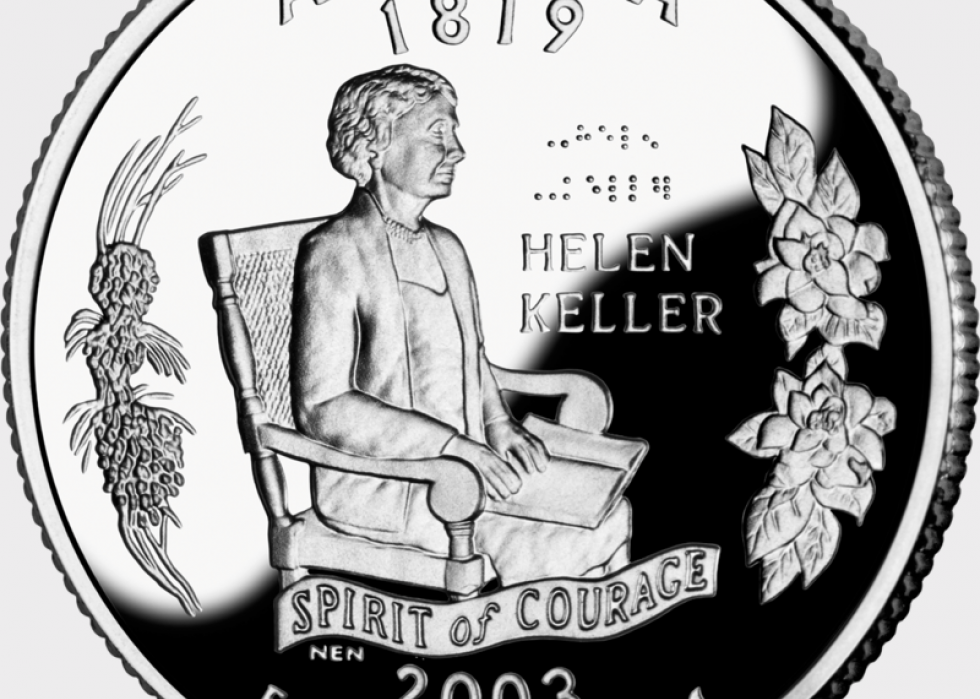
Alabama
Release date: March 17, 2003
Engraver: Norman E. Nemeth
Mintage: 457,400,000
The Alabama state quarter highlights an image of Alabama native Helen Keller—with her name printed in English and in a reduced-size version of Braille—and an Alabama long leaf pine branch with magnolias on the sides, along with a banner that says "Spirit of Courage." The Alabama quarter is the first U.S. coin to feature Braille.
The design came from a statewide competition for Alabama schools to submit concepts for the quarter. From thousands of entries, three were forwarded to the United States Mint: Helen Keller, Alabama's role in social movements, and Alabama's social and economic history. The United States Mint then sent five designs to the governor's office, where the final selection was made.
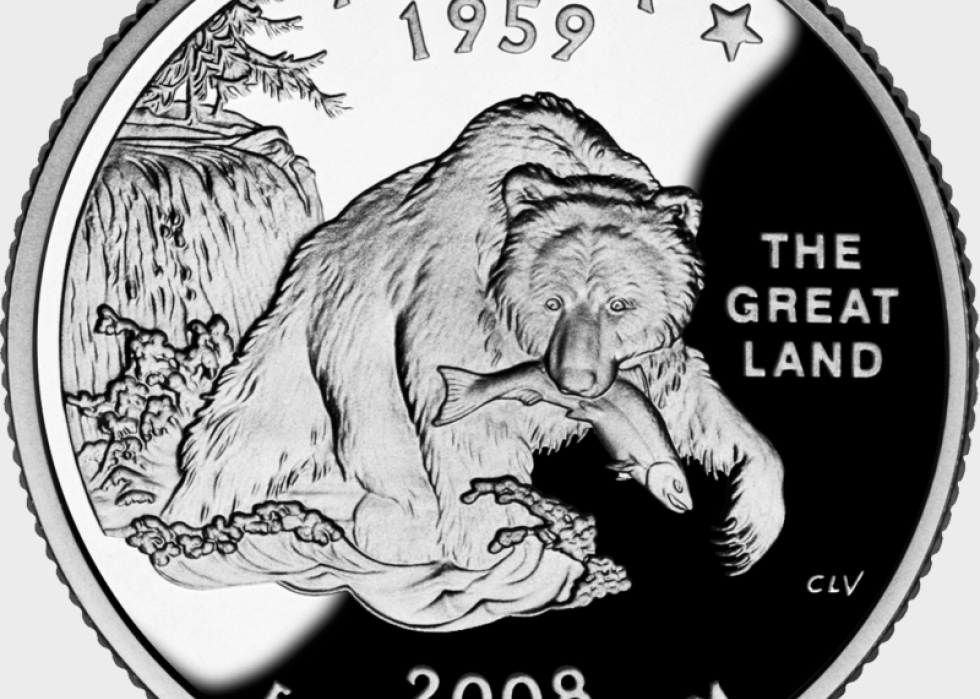
Alaska
Release date: Aug. 25, 2008
Engraver: Charles L. Vickers
Mintage: 505,800,000
The Alaska quarter features a grizzly bear emerging from the waters with a salmon. The coin's design includes the North Star and the engraving "The Great Land."
The design was chosen after The Alaska Commemorative Coin Commission asked citizens to submit suggestions. A number of 851 write-ins from around the state were incorporated into the four final designs: a sled-dog team, a polar bear, a gold panner, and a grizzly bear. The Commission received more than 30,000 votes on the four designs, and ultimately chose the latter. Fun fact: 98% of grizzlies in the country live in Alaska.
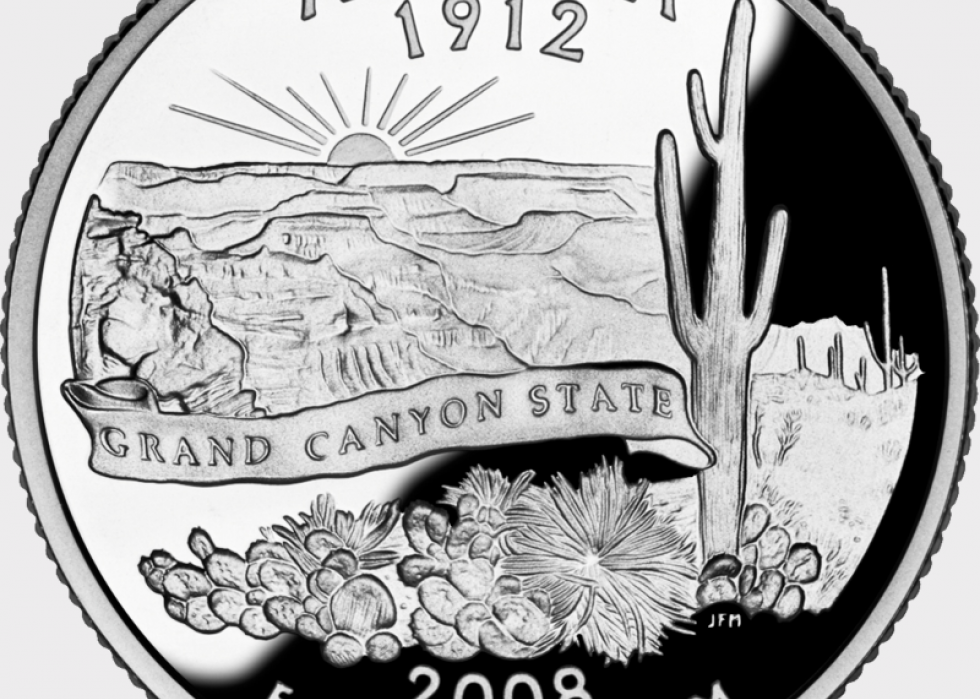
Arizona
Release date: June 2, 2008
Engraver: Joseph F. Menna
Mintage: 509,600,000
The Arizona quarter features an image of the Grand Canyon alongside a Saguaro cactus. A banner reading "Grand Canyon State" separates the two images, to signify that the Saguaro cactus does not grow actually in the Grand Canyon.
To create this design, the state received 4,200 suggestions from citizens, which were made into five final ideas that were sent to the Mint for approval and artistic rendering. The five images subsequently created were then voted on in a statewide online poll.
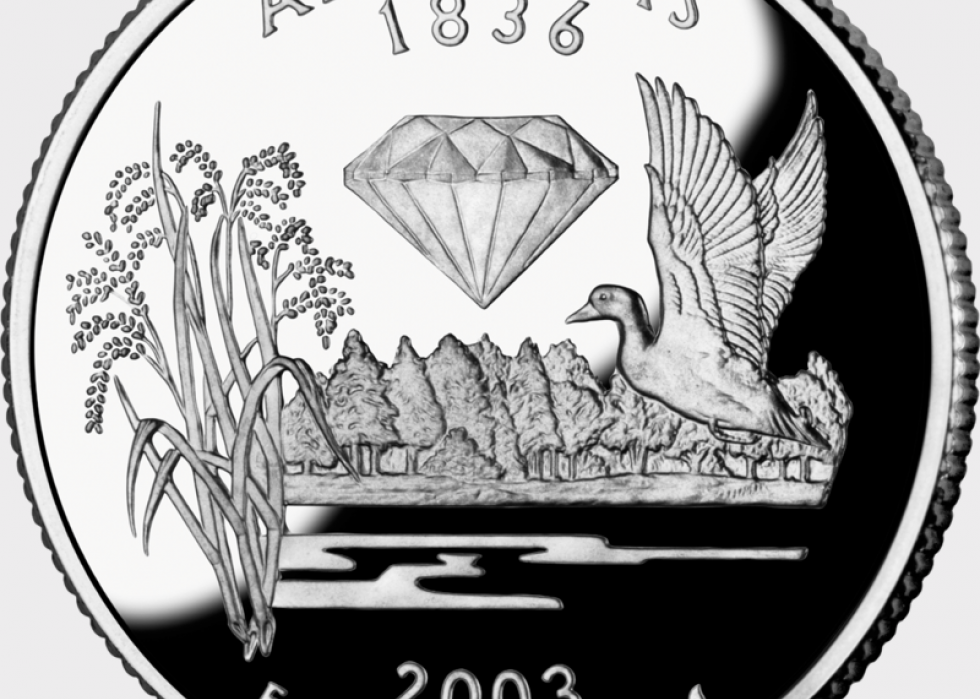
Arkansas
Release date: Oct. 20, 2003
Engraver: John Mercanti
Mintage: 457,800,000
Arkansas' coin highlights an image of rice stalks, a diamond, and a mallard gracefully flying above a lake.
For this design, there was a statewide competition with 9,320 entries. After several rounds of elimination, three concepts were sent to the United States Mint, including the Arkansas' natural resources design ultimately chosen by the governor. The diamond represents Arkansas' Crater of Diamonds State Park, which is the only diamond mine in the United States open to the public. Arkansas is also the nation's leading producer of rice.
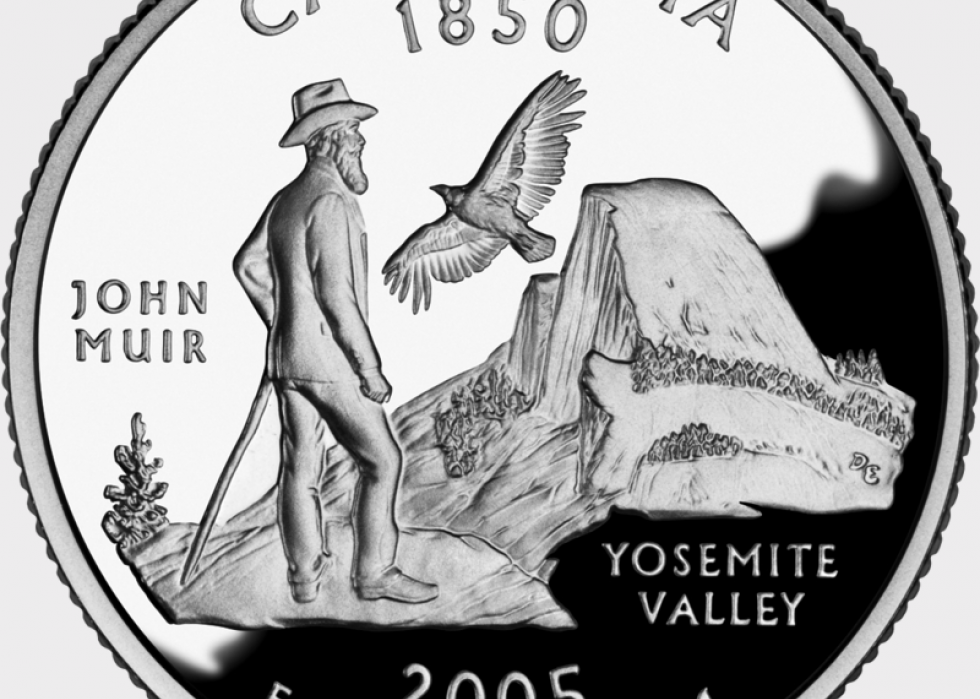
California
Release date: Jan. 31, 2005
Engraver: Don Everhart
Mintage: 520,400,000
California's coin features an image of a California condor along with conservationist John Muir admiring Yosemite Valley's monolithic granite headwall. Both "John Muir" and "Yosemite Valley" are inscribed into the quarter as well.
The design was taken from submissions after a statewide contest, which were then narrowed to 20 options by a specially appointed California State Quarter Commission. The governor of California at the time sent five to the United States Mint, including themes of "Waves and Sun" and "Golden Gate Bridge," but ultimately chose the Yosemite Valley option.
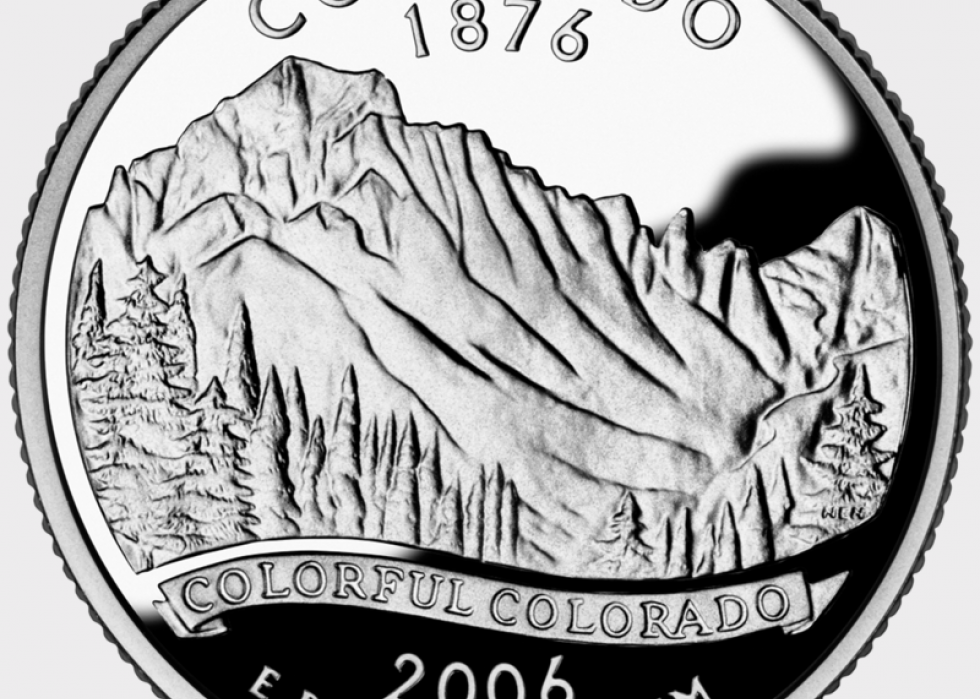
Colorado
Release date: June 14, 2006
Engraver: Norman E. Nemeth
Mintage: 569,000,000
The image highlights the Rocky Mountains, evergreen trees, and a banner with the inscription "Colorful Colorado."
More than 1,500 designs were submitted to a commission, which were then narrowed to five options. After the United States Mint sent back images, Bill Owens, the governor of Colorado at the time, made the final decision. "In the end, I made my selection based on what most people think of when they think of Colorado: our majestic Rocky Mountains," Owens said at the design unveiling.
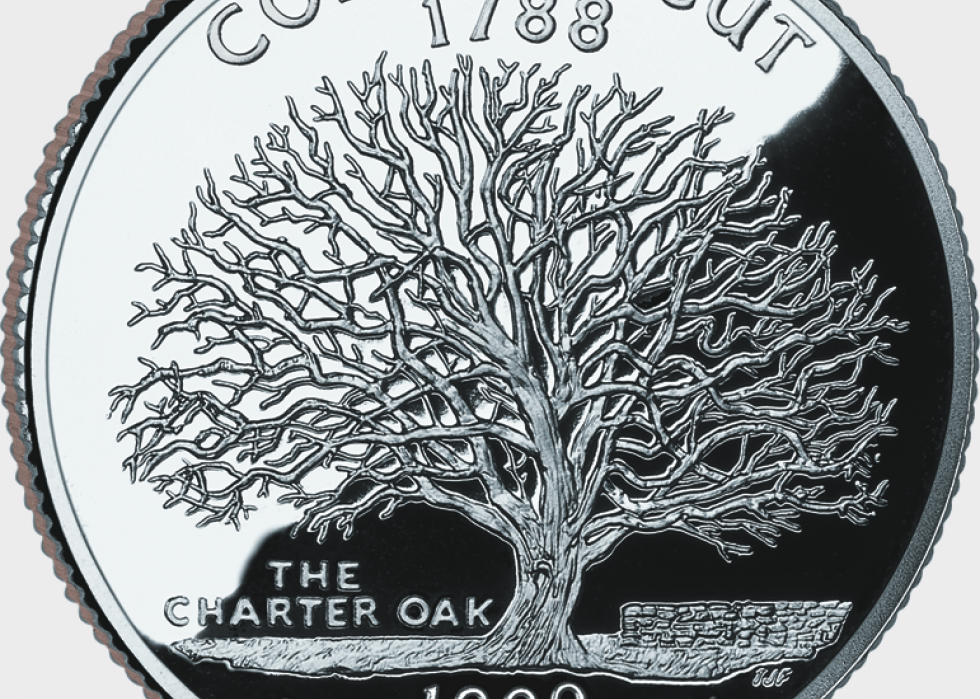
Connecticut
Release date: Oct. 12, 1999
Engraver: T. James Ferrell
Mintage: 1,346,624,000
Connecticut's coin highlights the Charter Oak tree, with both an inscription and image of the tree.
In 1687, a representative of King James II demanded the surrender of the Connecticut Charter, but Capt. Joseph Wadsworth hid the document in an oak tree. The state used the original charter as its constitution for more than 300 years. Fun fact: out of the 112 submissions from citizens, 19 included some rendition of the Charter Oak.

Delaware
Release date: Jan. 1, 1999
Engraver: William Cousins
Mintage: 774,824,000
The Delaware coin was the first released in the 50 State Quarters Program on Jan. 4, 1999. The coin's theme is "The First State," which is inscribed.
The coin celebrates Caesar Rodney's 80-mile horseback ride in 1776 to cast his vote in favor of Delaware signing the Declaration of Independence. Once the final three submissions were chosen, Rodney received 948 of the 1,519 total votes in a telephone and email poll.
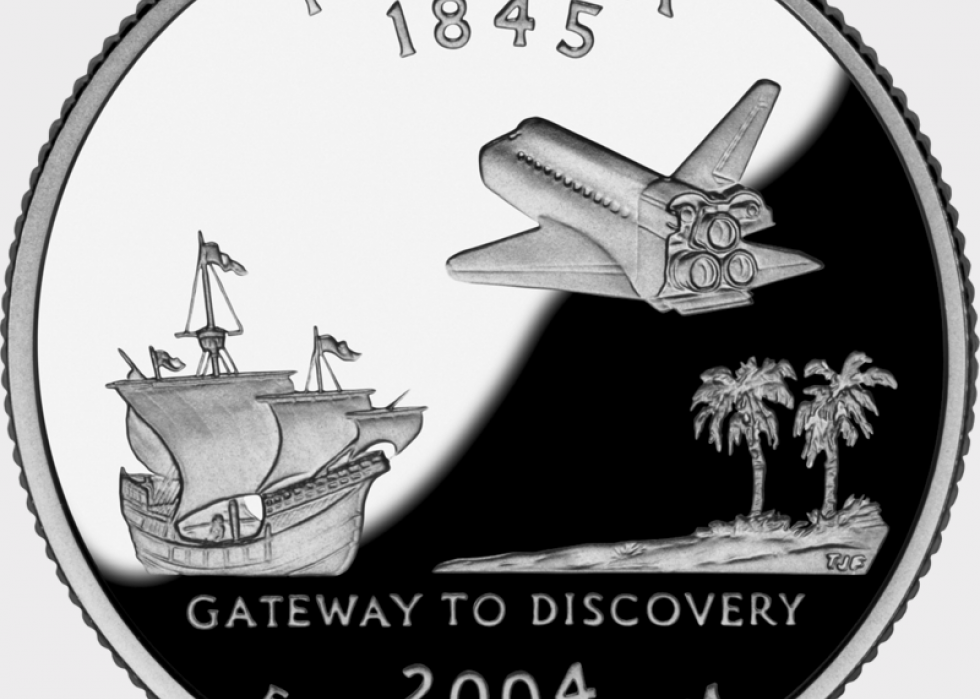
Florida
Release date: March 29, 2004
Engraver: T. James Ferrell
Mintage: 481,800,000
Florida themed its quarter "Gateway to Discovery," which is inscribed on the coin design as well. The coin highlights the 16th-century Spanish galleon, an image of a space shuttle, and Sabal palm trees. The Spanish galleon is similar to the ships of Ponce de Leon and Hernando de Soto, and the space shuttle represents Florida's Kennedy Center. In a three-week public vote, Floridians chose this design over four other finalists.
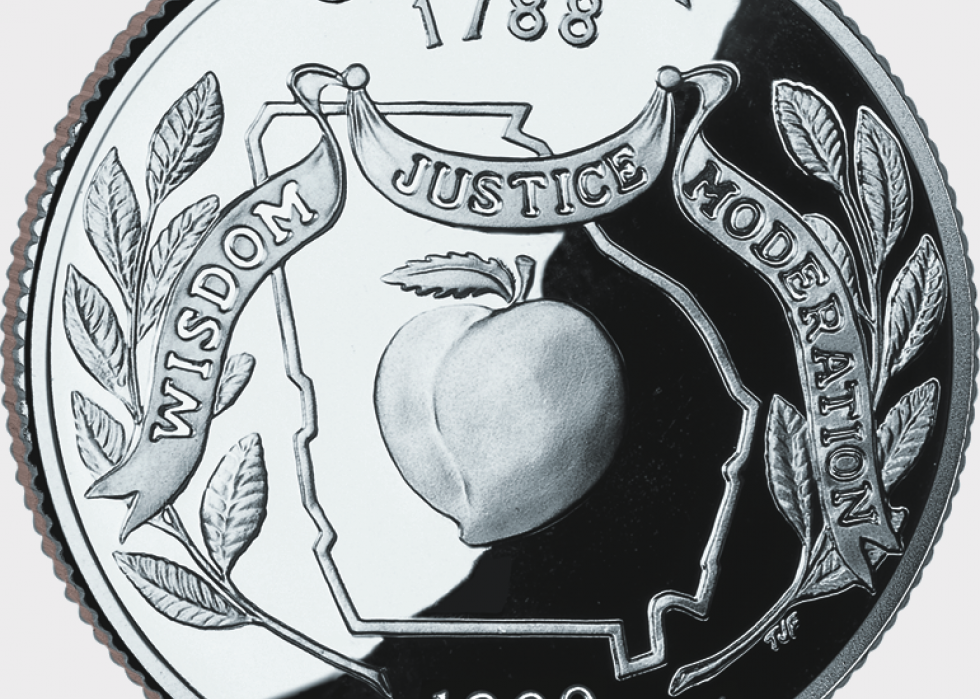
Georgia
Release date: July 19, 1999
Engraver: T. James Ferrell
Mintage: 939,932,000
This coin features a peach, a silhouetted outline of the state, live oak sprigs, and a banner with Georgia's motto, "Wisdom, Justice, Moderation." The peach is Georgia's state symbol and the live oak is Georgia's state tree. Both the governor and Georgia Council of the Arts agreed upon the final Georgia quarter design.

Hawaii
Release date: November 3, 2008
Engraver: Don Everhart
Mintage: 517,600,000
Hawaii's quarter features Hawaiian monarch King Kamehameha I stretching his hand toward the eight major Hawaiian Islands. This inscription also appears on the coin: "UA MAU KE EA O KA 'AINA I KA PONO" which is the state motto and means "The life of the land is perpetuated in righteousness." In an online poll of more than 26,000, this design beat out four other finalists including a hula dancer and a surfing design.
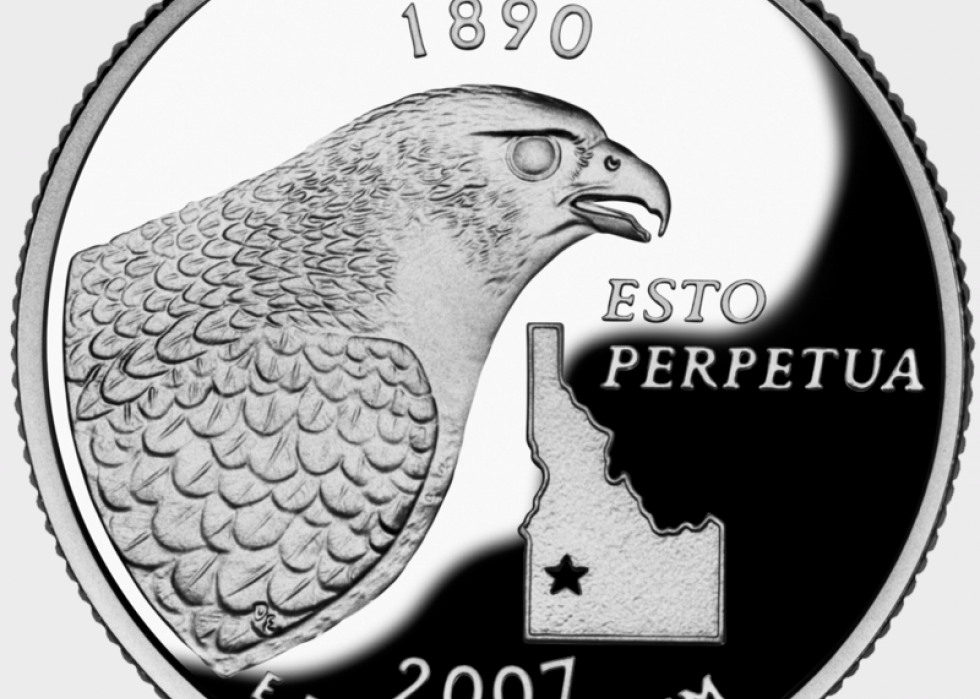
Idaho
Release date: June 4, 2007
Engraver: Don Everhart
Mintage: 581,400,000
The coin features an image of a peregrine falcon imposing its presence above an outline of the state of Idaho. The state's motto, "Esto Perpetua" which means, "May it be Forever," is also inscribed on the quarter.
Once on the endangered species list, the peregrine falcon—the state raptor of Idaho—is now found throughout the state and country thanks to conservation efforts. This design beat out other options, such as a farmland scenery image.
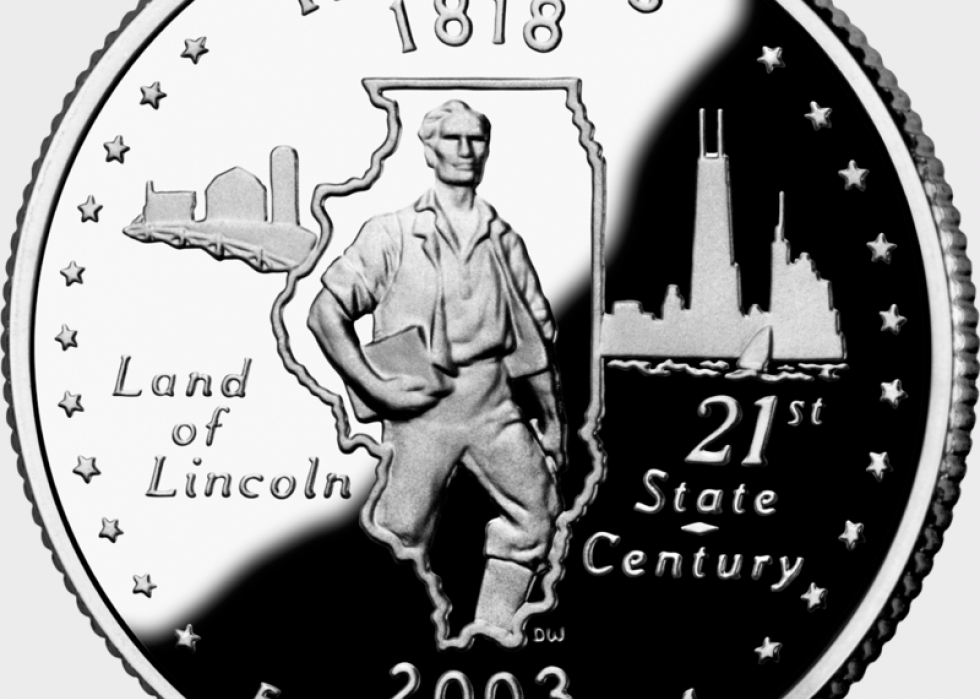
Illinois
Release date: Jan. 2, 2003
Engraver: Donna Weaver
Mintage: 463,200,000
The coin depicts young Illinois resident Abraham Lincoln within an outline of the state, a farm scene, and the Chicago skyline. "The Land of Lincoln" is inscribed on the quarter. There are 21 stars bordering the coin, which signifies Illinois as the 21st state admitted into the Union, as does the inscription "21st State Century."
Students mailed in more than 6,000 submissions, narrowed down to Illinois history, agriculture and industry, and state symbols.
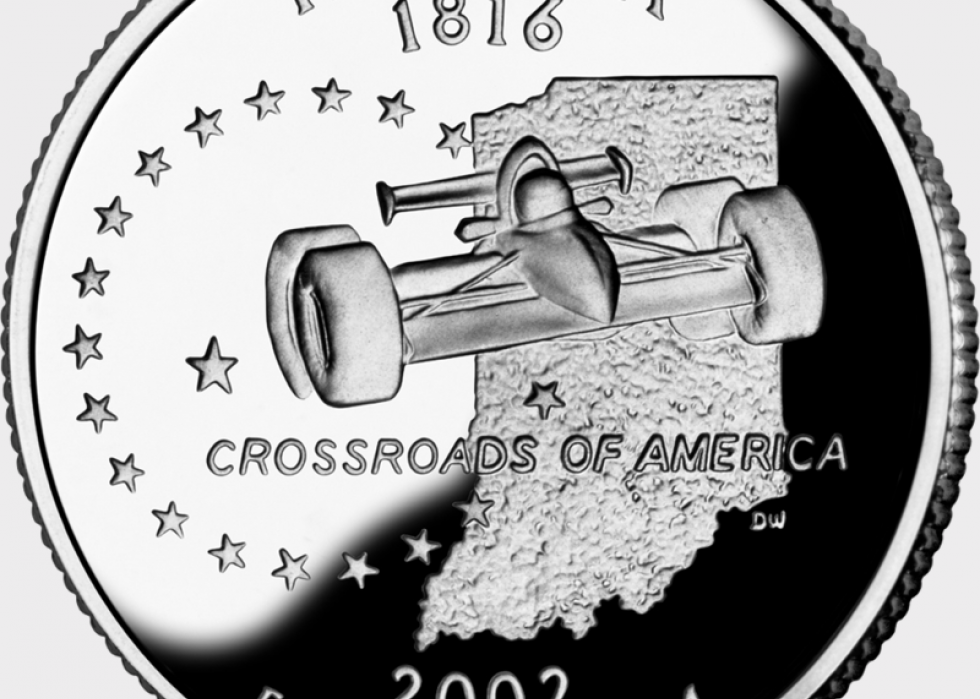
Indiana
Release date: Aug. 2, 2002
Engraver: Donna Weaver
Mintage: 689,800,000
Pictured on the coin is an image of a race car—which represents the Indianapolis 500—superimposed on an outline of the state, along with 19 stars, which signifies that the state was the 19th admitted into the Union. The coin's theme is also inscribed on the quarter: "Crossroads of America."
Fun fact: Races at the Indianapolis Motor Speedway have been held every year since 1911, except during the two world wars.
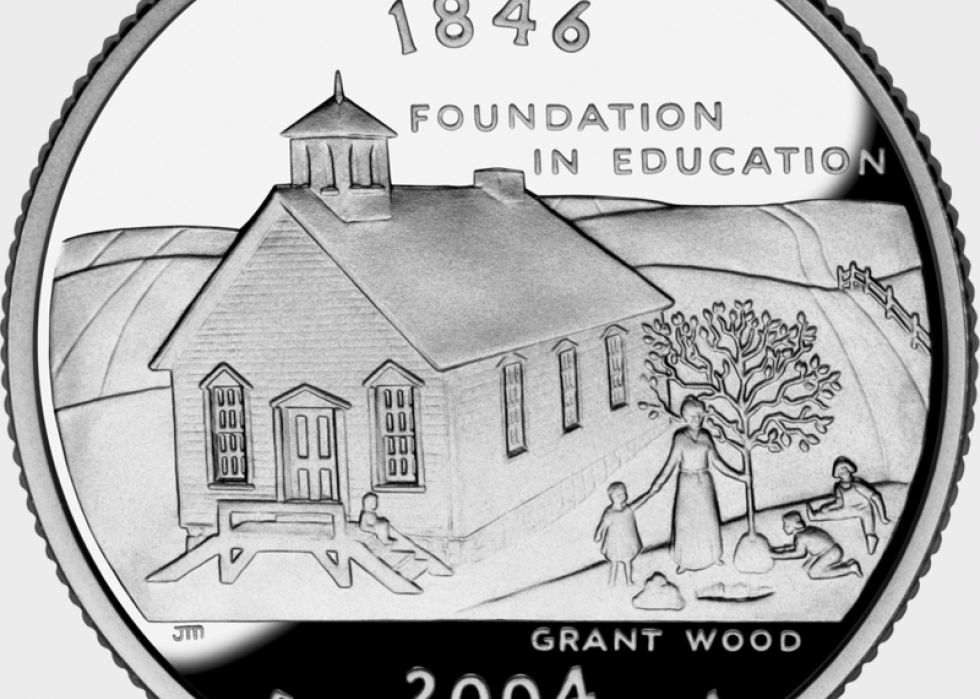
Iowa
Release date: Aug. 30, 2004
Engraver: John Mercanti
Mintage: 465,200,000
The coin depicts a one-room schoolhouse with a teacher and students planting a tree, and the inscriptions "Foundation in Education" and "Grant Wood."
Iowa's design is based on "Arbor Day," a painting by Grant Wood, who was born in Iowa. When Iowa became a state in 1846, it already had several schools in each of its counties. A high school opened up a few years later—a rarity at the time.
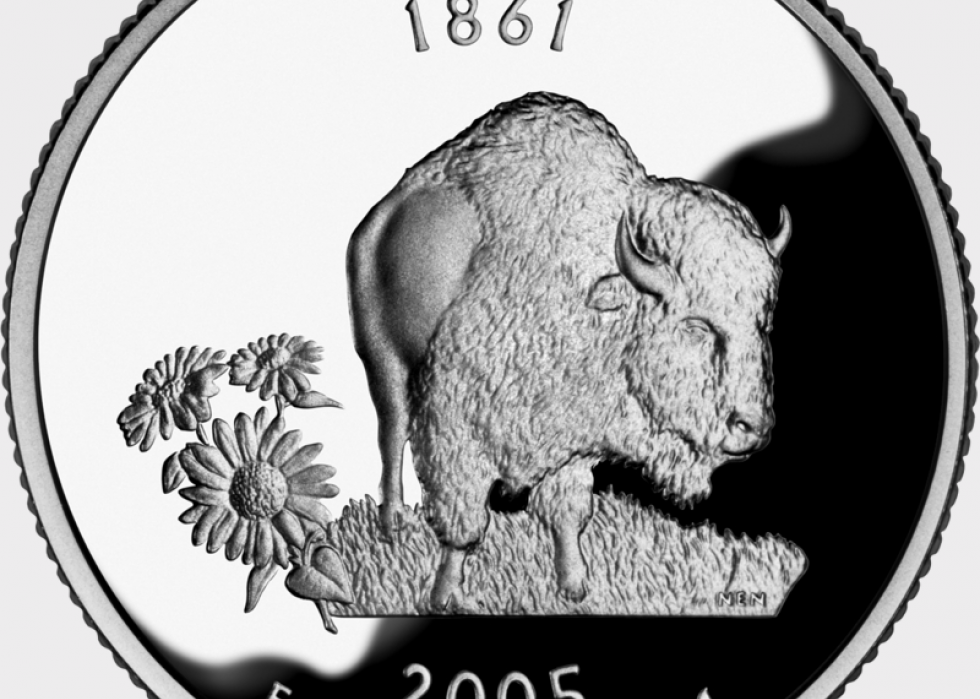
Kansas
Release date: Aug. 29, 2005
Engraver: Norman E. Nemeth
Mintage: 563,400,000
The quarter displays an image of a buffalo, the state animal, and sunflower, the state flower. Both the buffalo and the sunflower were found throughout Kansas in the mid-1800s when Kansas became a state. It was the 34th coin issued in the United States Mint's 50 State Quarters Program.
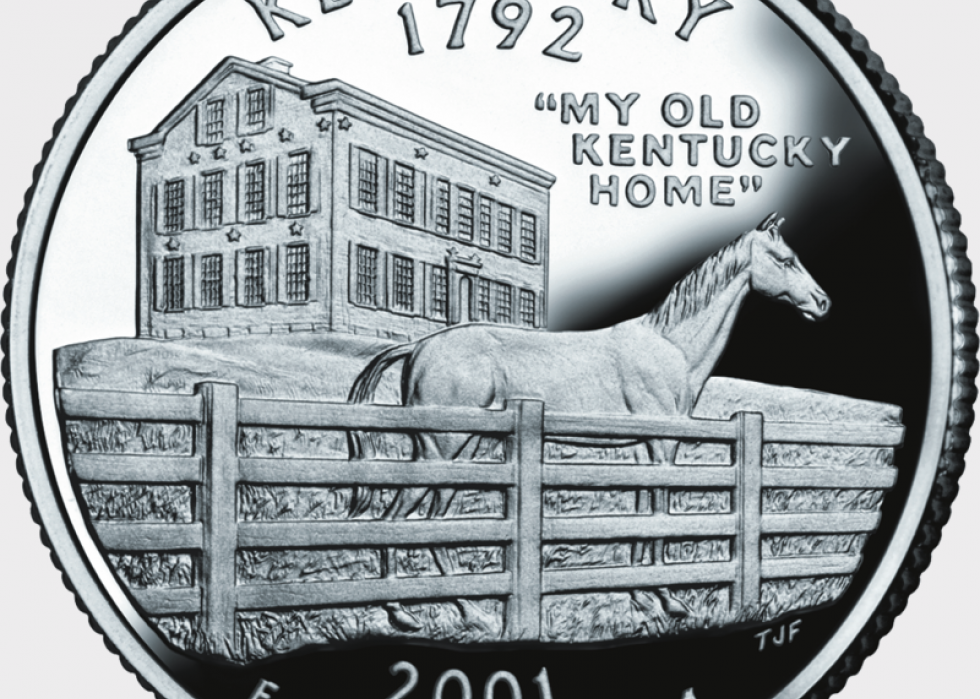
Kentucky
Release date: Oct. 15, 2001
Engraver: T. James Ferrell
Mintage: 723,564,000
The coin features the mansion Federal Hill and a thoroughbred racehorse positioned behind a fence in the foreground, and bears the inscription, "My Old Kentucky Home."
The design's racehorse represents the longest running annual horse race in the country, the Kentucky Derby. The mansion in the background is where Stephen Foster wrote the state song, "My Old Kentucky Home." Other design options included a Daniel Boone theme and a depiction of the state's legacy as Abraham Lincoln's birthplace.
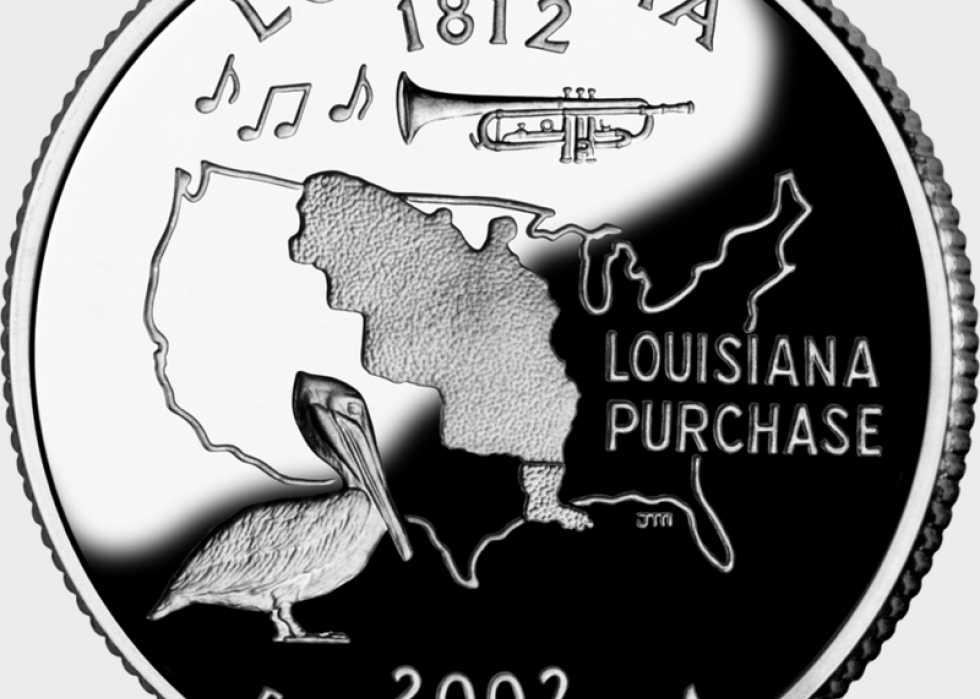
Louisiana
Release date: May 20, 2002
Engraver: John Mercanti
Mintage: 764,204,000
Featured on the coin is Louisiana's state bird, the pelican, as well as a trumpet with musical notes, and the outline and inscription of the Louisiana Purchase territory.
The Louisiana Territory was the largest single expansion of the United States, and doubled the size of the country. The trumpet with musical notes represents jazz, which has its roots in New Orleans. Of the 1,193 submissions the Louisiana Commemorative Coin Advisory Commission received, a large majority came from students.
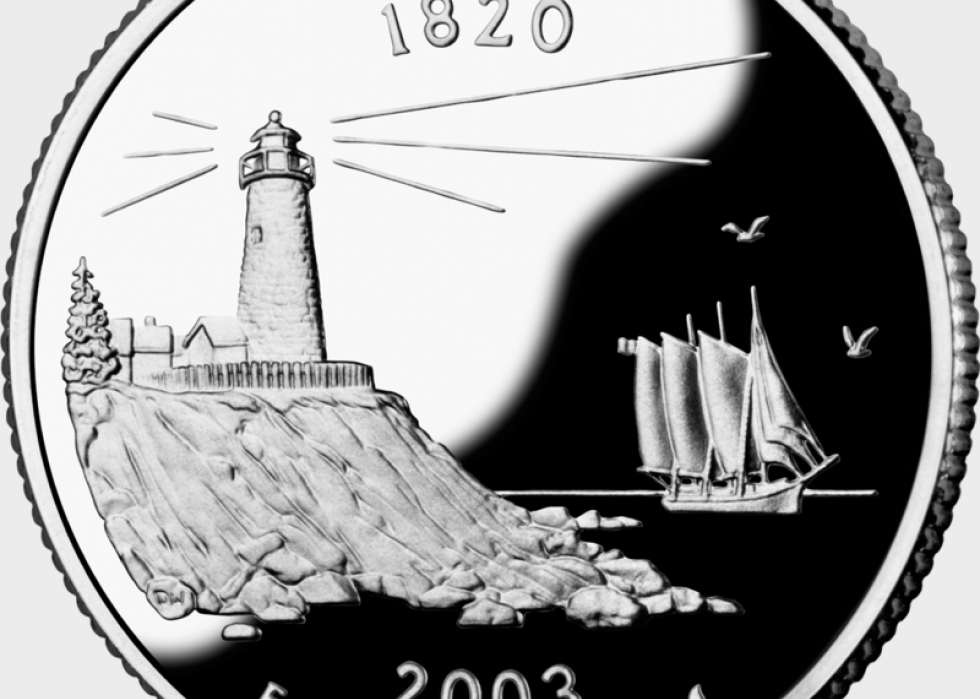
Maine
Release date: June 2, 2003
Engraver: Donna Weaver
Mintage: 448,800,000
The coin depicts the Pemaquid Point Light atop a granite coast, and a schooner at sea. The light is still a beacon for ships, and remains one of Maine's most popular tourist attractions. The schooner represents Victory Chimes, the last three-masted schooner of the Windjammer Fleet. The Pemaquid Point Light design was chosen by popular vote, with more than 100,000 Maine residents participating.

Maryland
Release date: March 13, 2000
Engraver: Thomas D. Rogers
Mintage: 1,234,732,000
The quarter features the Maryland State House, and is surrounded by white oak leaves—for the state tree—with the inscription "The Old Line State," the state's nickname.
The State House is the only state house in the country to have served as the nation's capital, and is the oldest one still used regularly by a legislature. The Continental Congress met in the unfinished building, signing the Treaty of Paris that ended the Revolutionary War.
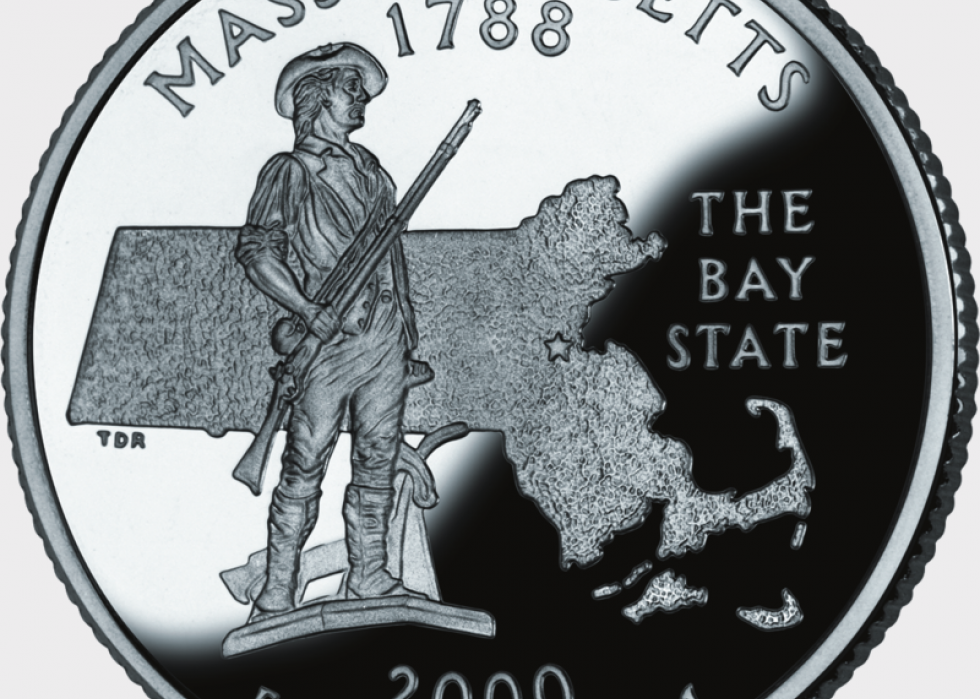
Massachusetts
Release date: Jan. 3, 2000
Engraver: Thomas D. Rogers
Mintage: 1,163,784,000
The coin depicts a famous statue of the celebrated Minuteman of the American Revolution against an outline of the state with the inscription "The Bay State."
Year-round, this statue stands guard at the 900-acre Minute Man National Historical Park in Concord, Massachusetts. Certain soldiers were called "minutemen" during the American Revolutionary War because they could be ready for battle at a minute's notice. Only kids could submit quarter designs in the 1998 contest, and a sixth- and seventh-grader came up with the winner.
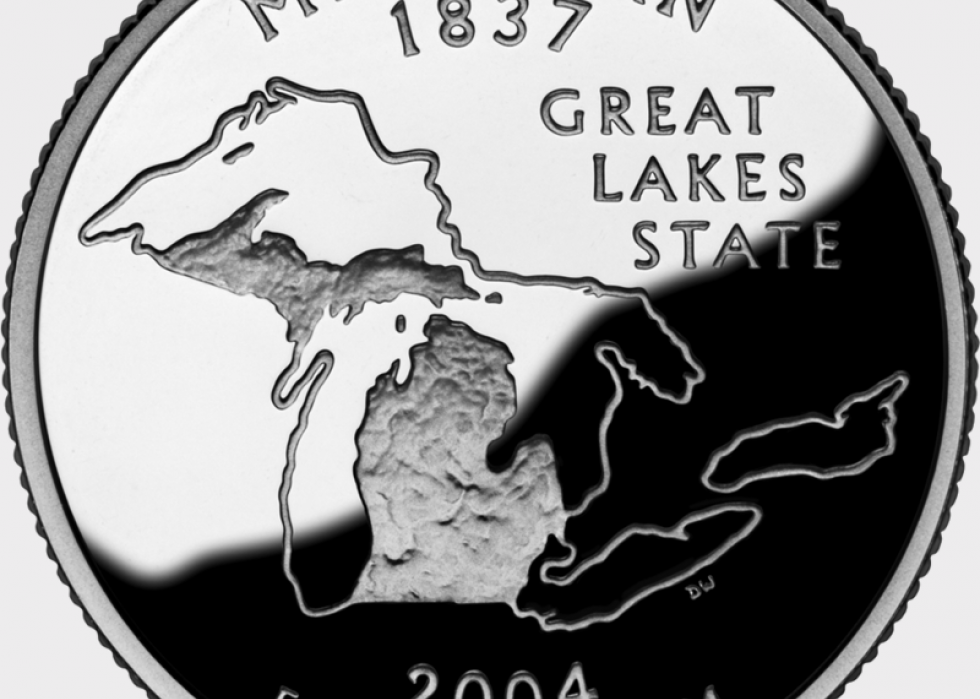
Michigan
Release date: Jan. 26, 2004
Engraver: Donna Weaver
Mintage: 459,600,000
This was the 26th coin released in the 50 State Quarters Program, and the first released in 2004. It shows an outline of Michigan and the Great Lakes system with the inscription "Great Lakes State."
These lakes, which together make the largest body of fresh water in the world, have played a major part in Michigan's history and economy by bringing tourists and industries to Michigan's shores. The 25-member Michigan Quarter Commission chose five designs after receiving more than 4,300 from the State's residents.
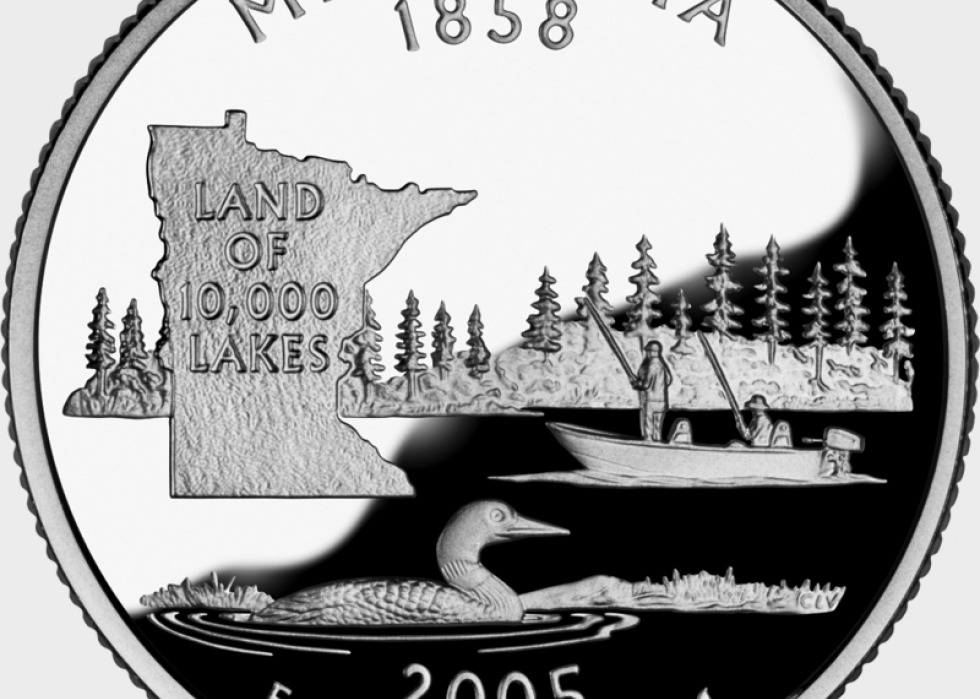
Minnesota
Release date: April 4, 2005
Engraver: Charles L. Vickers
Mintage: 488,000,000
Minnesota's coin features an image of a tree-lined lake with two people fishing, a loon on the water, and a textured outline of the state surrounding its nickname: "Land of 10,000 Lakes."
The loon is Minnesota's state bird, and the lake represents the many lakes that exist in the state—far more than 10,000. Other designs considered were the "State with Symbols," including a snowflake, loon and plow, "Mississippi River Headwaters," and a "Fisherman/Lake Recreation" theme.
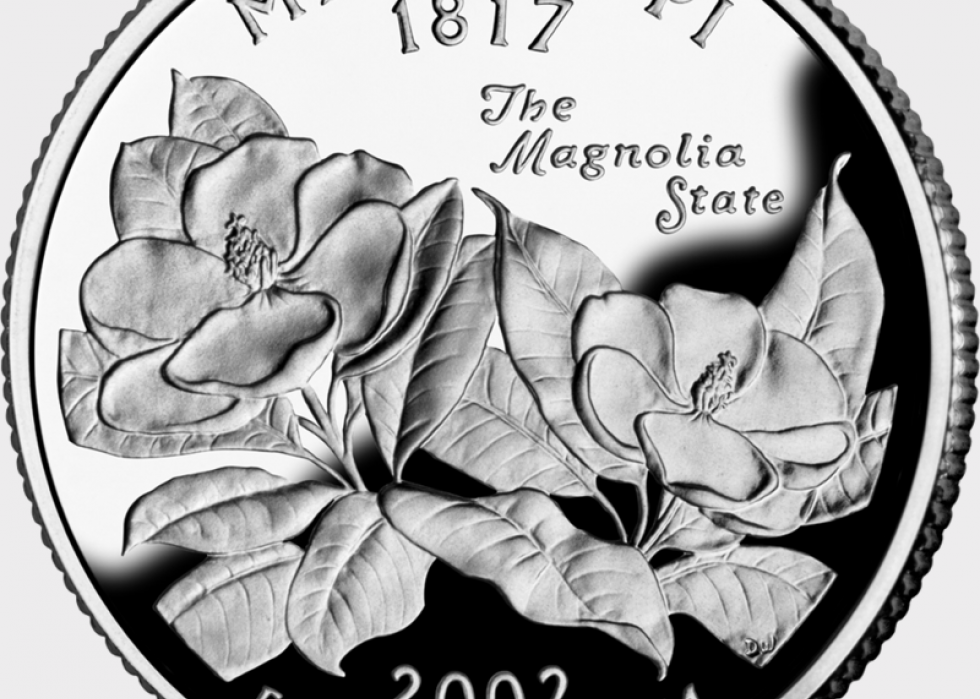
Mississippi
Release date: Oct. 15, 2002
Engraver: Donna Weaver
Mintage: 579,600,000
Mississippi's coin showcases the beauty and elegance of the state flower, combining the blossoms and leaves of two magnolias.
The magnolia, named for the French botanist Pierre Magnol, is strongly associated with the South. In 1900, Mississippi students were asked to choose a state flower, and the magnolia won easily. In 1935, school children voted for a state tree and the magnolia tree won.
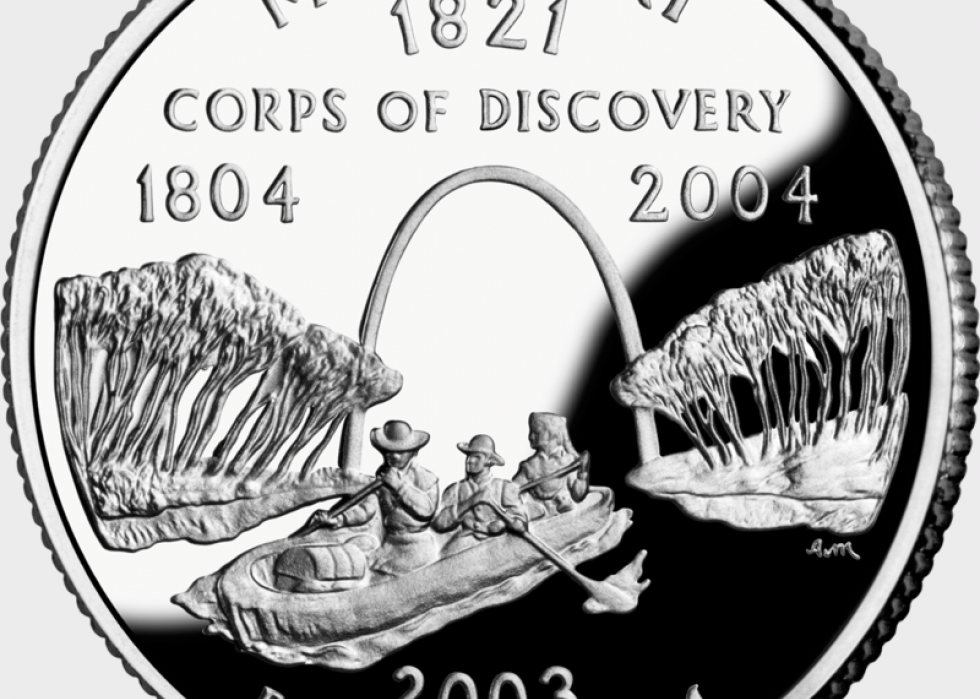
Missouri
Release date: Aug. 4, 2003
Engraver: Alfred Maletsky
Mintage: 453,200,000
Missouri's coin is themed "Corps of Discovery," and commemorates Lewis and Clark's historic return to St. Louis down the Missouri River. Jefferson National Expansion Memorial Gateway Arch is depicted in the coin's background. The 8,000-mile journey began in 1804 in St. Charles, Missouri—just 20 miles west of St. Louis—and ended when they returned in 1806.
The state received more than 3,000 concept submissions. The Missouri Commemorative Quarter Design Committee, composed of a team of experts, selected 12 finalists that were presented to the public. Five concepts were chosen to forward to the United States Mint. The final design was chosen by an online vote.
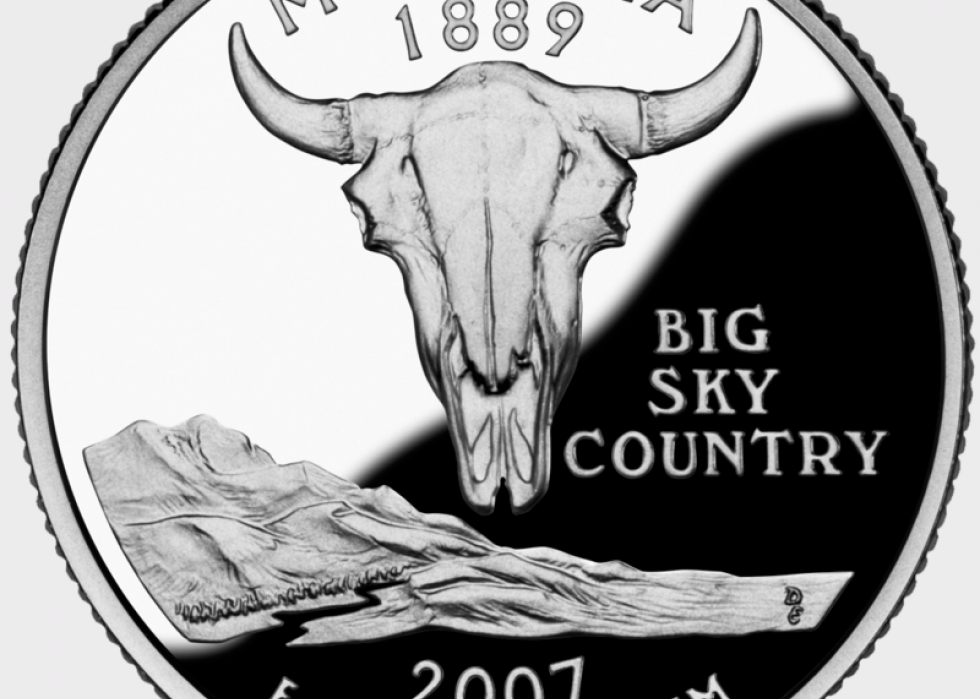
Montana
Release date: Jan. 29, 2007
Engraver: Don Everhart
Mintage: 513,240,000
This coin's theme is "Big Sky Country," which is inscribed. It depicts a bison skull above the diverse Montana landscape. The bison skull represents the American Indian heritage of the state. The tribes that lived on this land depended on bison for food and clothing.
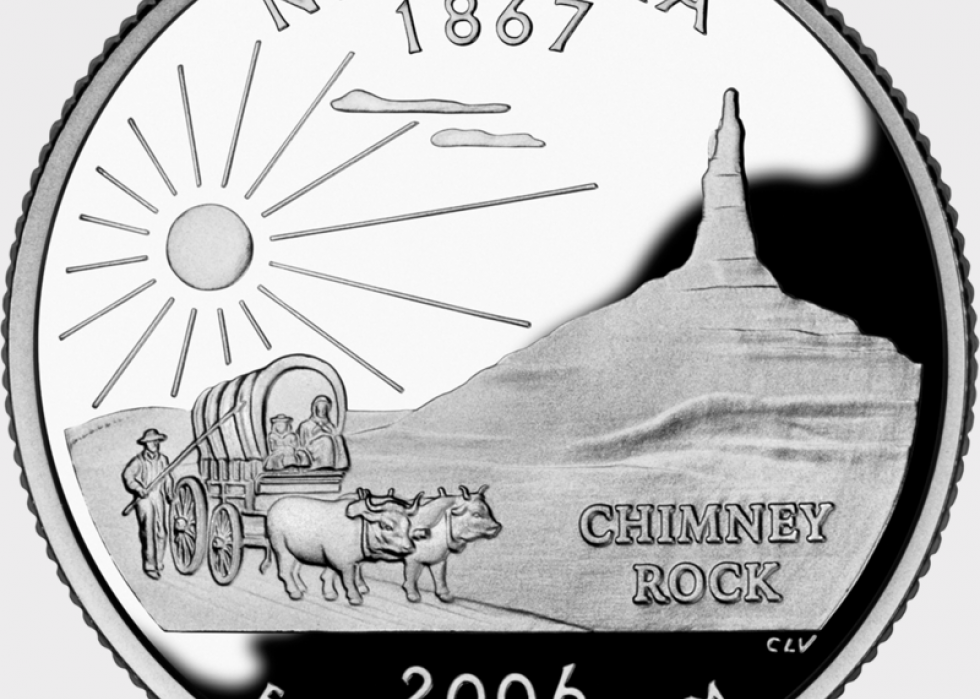
Nebraska
Release date: April 3, 2006
Engraver: Charles L. Vickers
Mintage: 594,400,000
This coin depicts an ox-drawn covered wagon carrying pioneers with Chimney Rock in the background. The covered wagon in the coin's design is carrying a family to California, illustrating that Nebraska was home to many westward trails, including the Oregon Trail. Chimney Rock is a large rock structure that stands at 445 feet, and was named a National Historic Site in 1956.
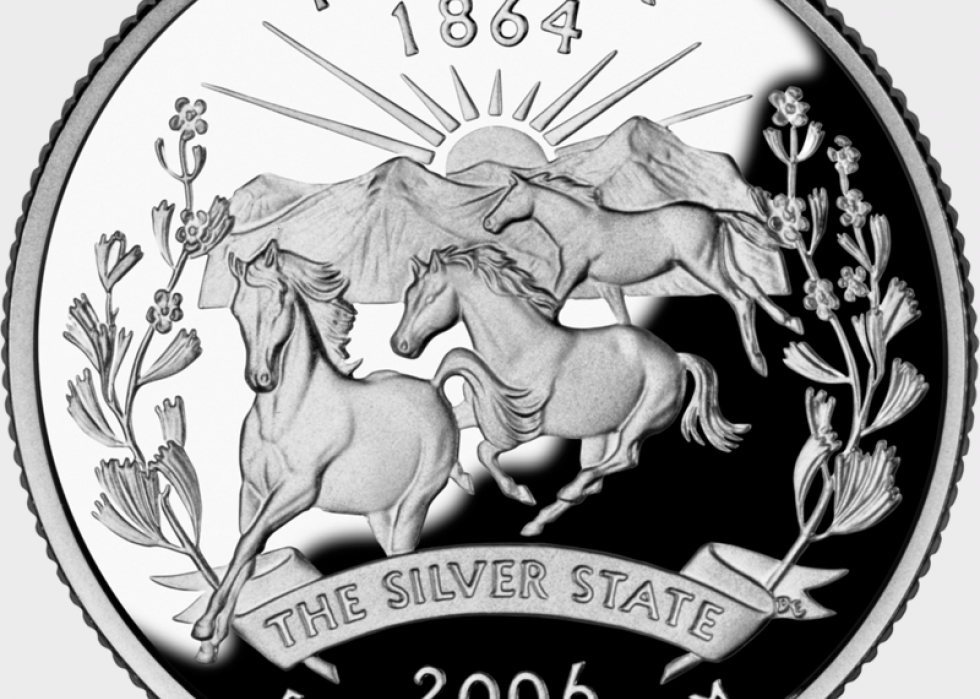
Nevada
Release date: Jan. 31, 2006
Engraver: Don Everhart
Mintage: 589,800,000
Nevada's coin highlights a trio of wild stallions, sagebrush, snow-capped mountains and the sun, along with the inscription "The Silver State." Nevada is home to more than half of the nation's wild horses, which roam the deserts and mountains between the Rocky Mountains and the Sierra Nevada. "The Silver State" refers to the nickname that commemorates the Comstock Lode of silver ore that was the first discovered in the United States.
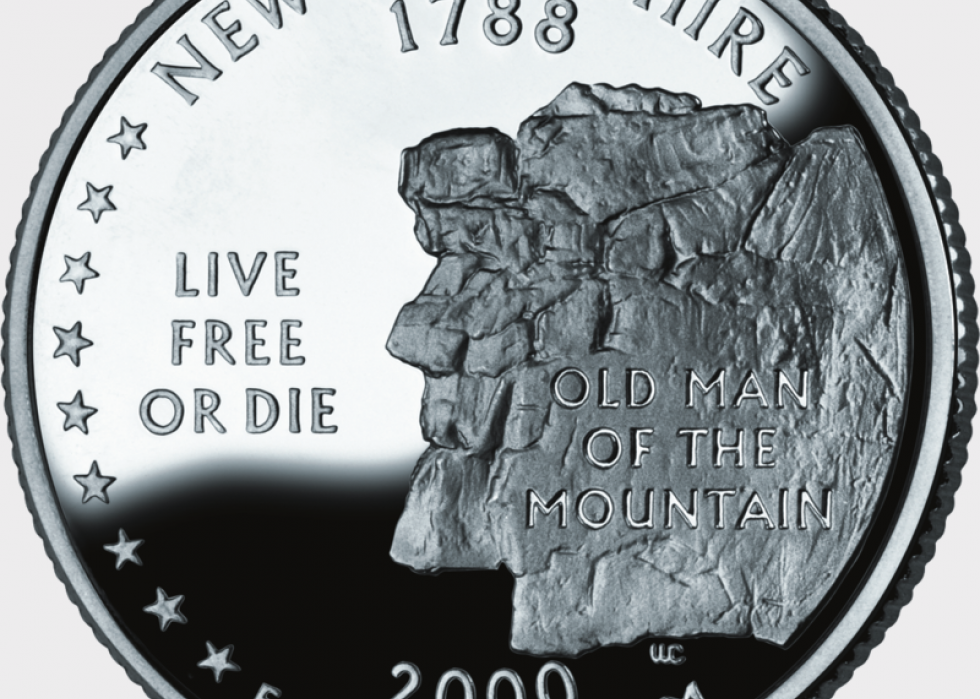
New Hampshire
Release date: Aug. 7, 2000
Engraver: William Cousins
Mintage: 1,169,016,000
The New Hampshire coin features the rock formation "the Old Man of the Mountain," as well as the state motto, "Live free or die," and nine stars bordering the coin. These stars signify New Hampshire as the ninth state admitted into the Union.
The Old Man of the Mountain, formed 200 years ago, is the state's most famous natural rock features at 25 feet wide and 40 feet from the chin to forehead. Sadly, it collapsed in 2003. Gen. John Stark, a Revolutionary War hero, is credited with coining the phrase "Live Free or Die."
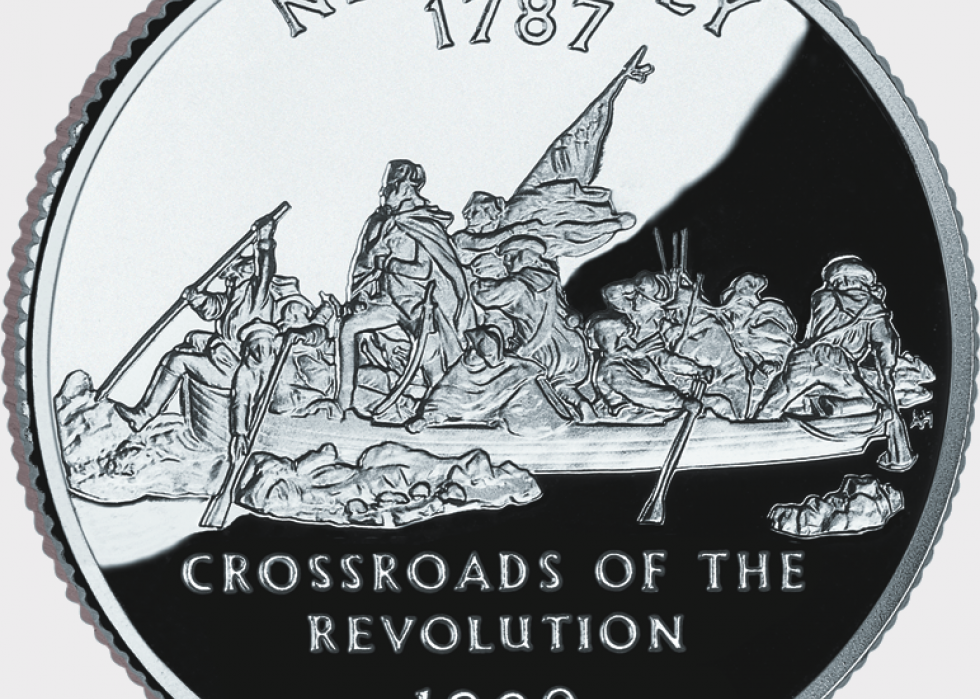
New Jersey
Release date: May 17, 1999
Engraver: Alfred Maletsky
Mintage: 662,228,000
This coin's theme is "Crossroads of the Revolution." It shows George Washington as a general crossing the Delaware River with soldiers on their way to victory against the British at the battles of Trenton and Princeton.
New Jersey's location put it at the center of famous Revolutionary battles that subsequently earned it the nickname "Crossroads of the Revolution." The coin design is based on an 1851 painting by Emanuel Leutze. The design was selected by a coin commission after state residents offered individual ideas and renderings to include on the quarter.
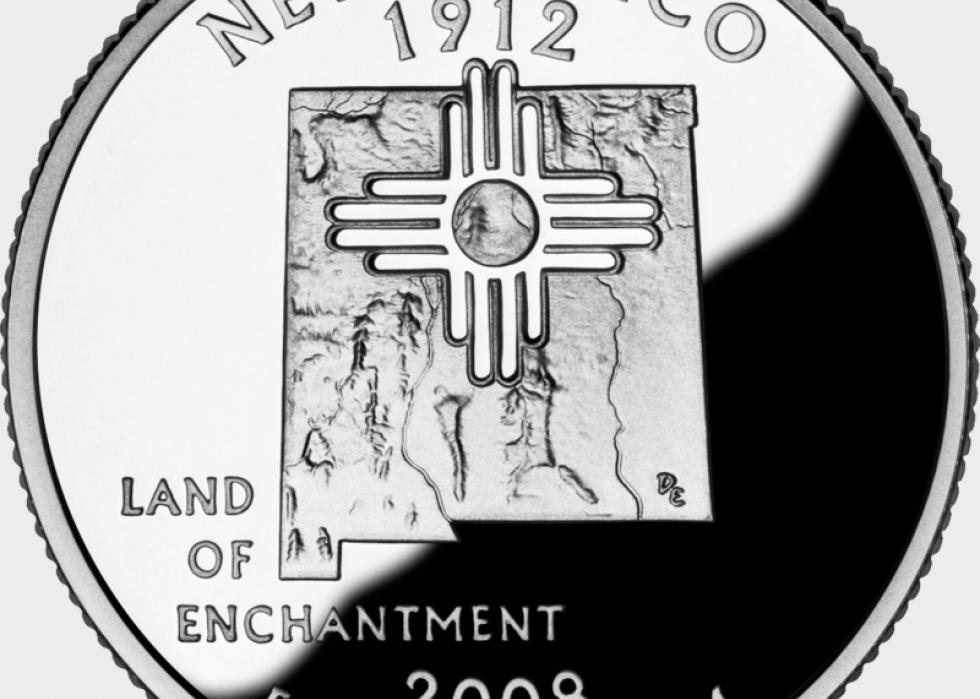
New Mexico
Release date: April 7, 2008
Engraver: Don Everhart
Mintage: 488,600,000
New Mexico's quarter features a Zia sun symbol over a topographical outline of the state, with the inscription "Land of Enchantment." The location of the capital city, Santa Fe, is marked by a Zia sun symbol. This symbol, from the Zia Pueblo people, represents the giver of all good. All four of the finalists for the coin had an outline of New Mexico and the Zia sun symbol. The symbol is also on the state flag.
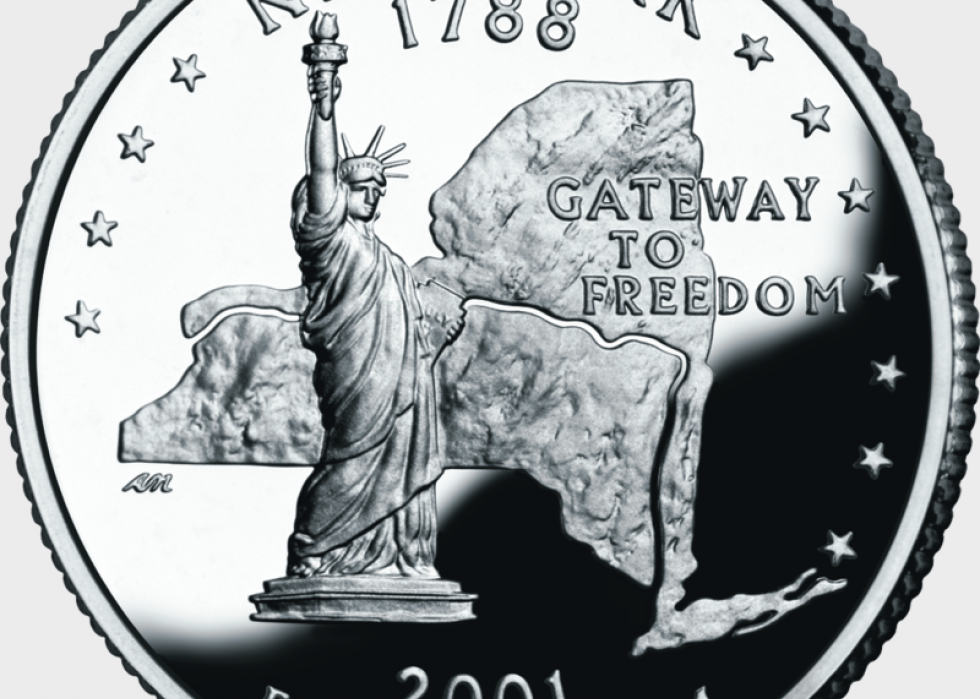
New York
Release date: Jan. 2, 2001
Engraver: Alfred Maletsky
Mintage: 1,275,040,000
This quarter bears an image of the Statue of Liberty, the state outline, and 11 stars that represents its position when admitted into the Union, along with the inscription "Gateway to Freedom." Lines tracing the Hudson River and Erie Canal are also etched into the state's outline.
This design received 76% of the final vote after a two-year selection process and beat out other options, including Henry Hudson and his ship and a rendering of the Battle of Saratoga.
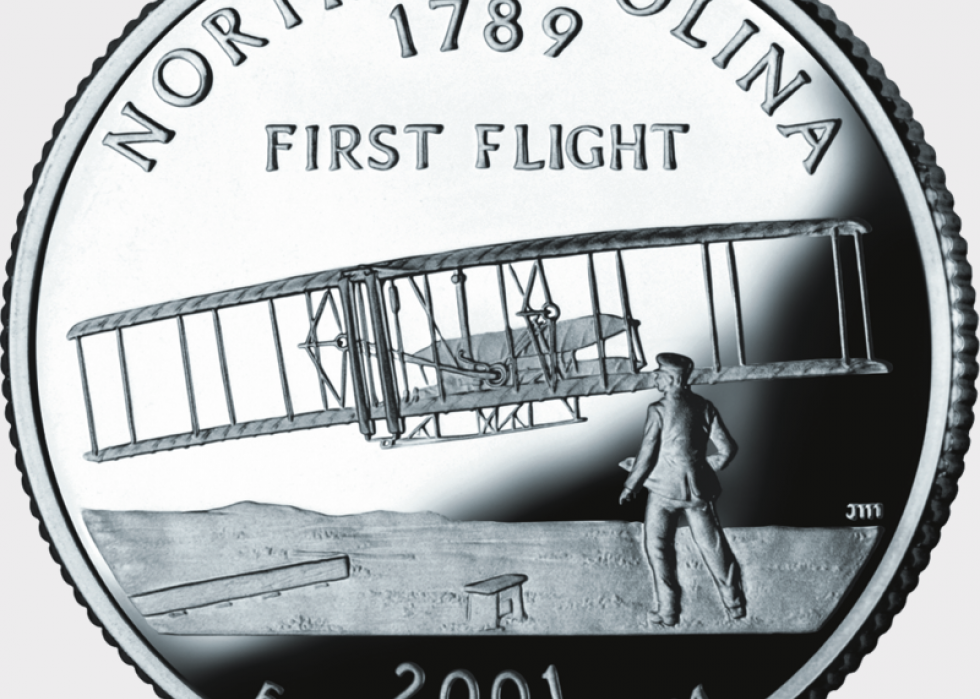
North Carolina
Release date: March 12, 2001
Engraver: John Mercanti
Mintage: 1,055,476,000
The coin displays an engraving of the iconic photograph of the Wright Brothers' successful first flight in Kitty Hawk on Dec. 17, 1903, as well as the inscription "First Flight." Called the Flyer, the plane traveled a distance of approximately 120 feet on its first flight, staying in the air for 12 seconds.
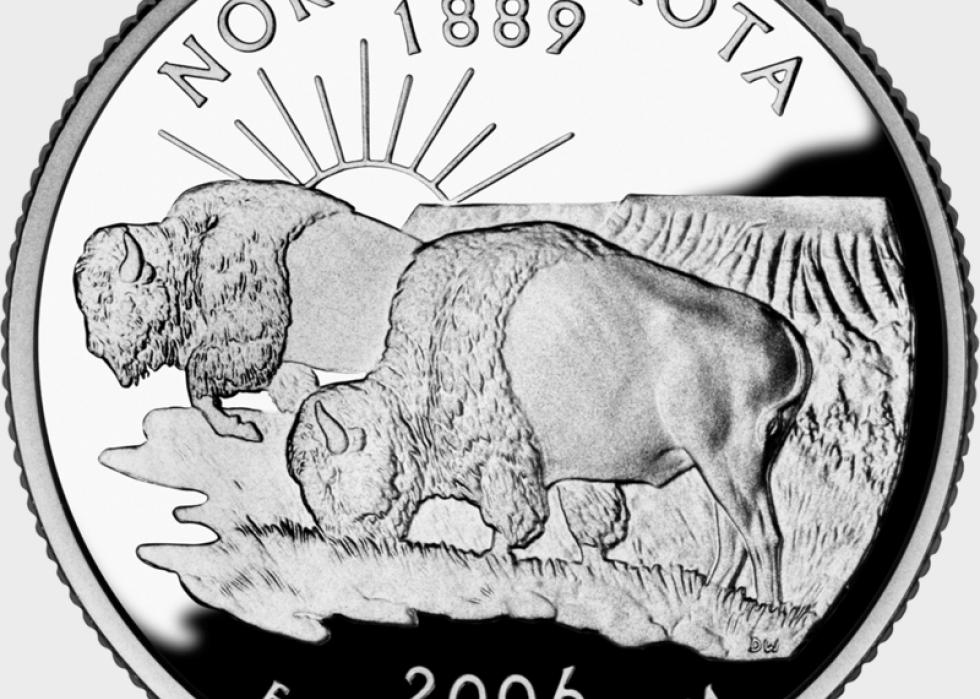
North Dakota
Release date: Aug. 28, 2006
Engraver: Donna Weaver
Mintage: 664,800,000
This coin depicts a pair of grazing American bison in the foreground, a sunset view of the rugged buttes, and canyons that symbolize the State's Badlands region. Part of the Badlands is now in Theodore Roosevelt National Park, where elk, prairie dogs, and bison thrive. More than 400 wild buffalo now live in the park, as well. The other two finalists were an agricultural theme and the state's sweeping landscape.
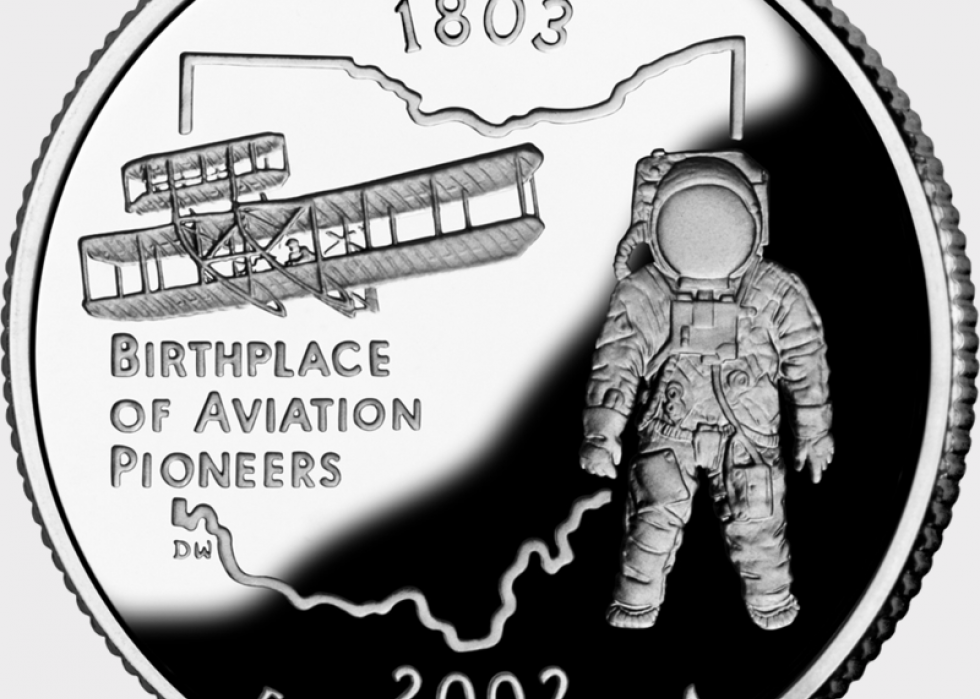
Ohio
Release date: March 11, 2002
Engraver: Donna Weaver
Mintage: 632,032,000
The coin commemorates the state's contribution to the history of aviation. It features an early aircraft and an astronaut on the outline of the state, along with the inscription "Birthplace of Aviation Pioneers." Not only was one-half of the famous Wright brothers duo born there, so were astronauts Neil Armstrong and John Glenn, represented by the anonymous space suit on the coin. Ohio put six designs up for an online vote to choose the winner.
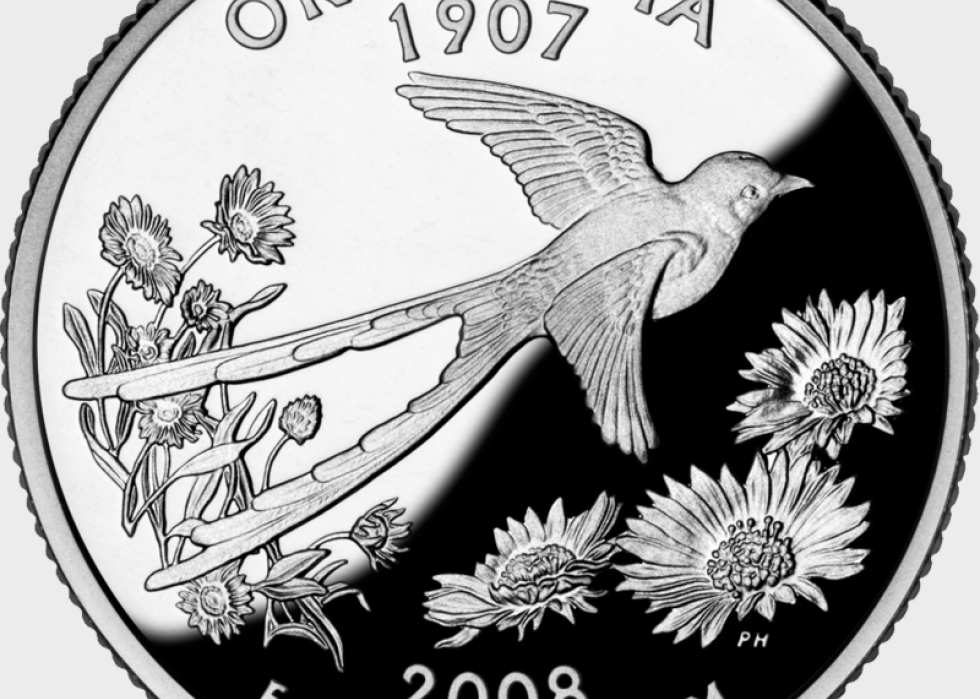
Oklahoma
Release date: Jan. 28, 2008
Engraver: Phebe Hemphill
Mintage: 416,600,000
The Oklahoma quarter features an image of the State bird, the scissor-tailed flycatcher, in flight with its distinctive tail feathers spread. The bird is soaring over the state wildflower, the Indian Blanket. The Indian blanket symbolizes Oklahoma's rich American Indian heritage, its native long grass prairies, and abundant wildlife.
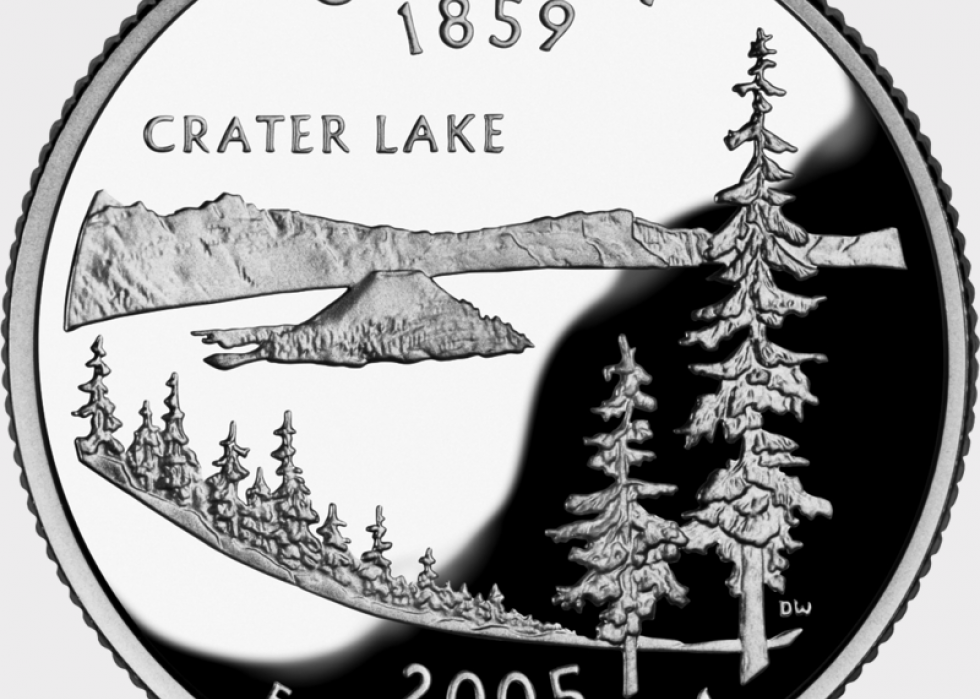
Oregon
Release date: June 6, 2005
Engraver: Donna Weaver
Mintage: 720,200,000
The coin depicts an image of Crater Lake. The image is viewed from the southwest to include Wizard Island and Watchman and Hillman Peaks in the lake's rim. The Crater Lake design won against a jumping salmon, the Oregon Trail, and Mount Hood. Fun fact: Crater Lake is the deepest lake in the United States, the seventh-deepest lake in the world, and was formed in the crater of a volcano.
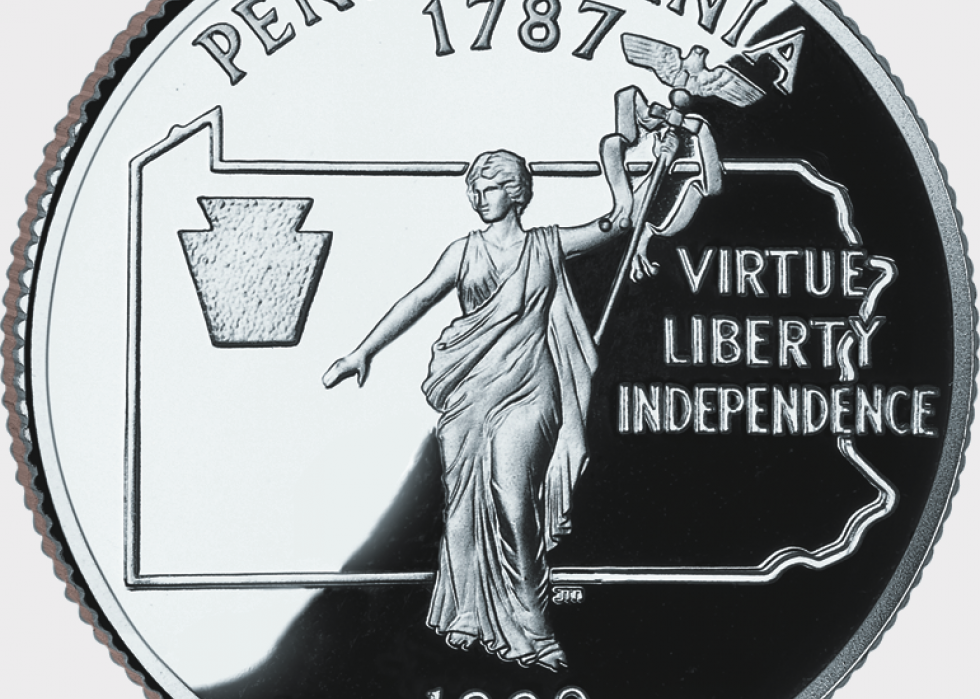
Pennsylvania
Release date: March 8, 1999
Engraver: John Mercanti
Mintage: 707,332,000
The second coin released in the 50 State Quarters Program, Pennsylvania's quarter features the statue Commonwealth and a keystone, along with an outline of the state and its motto: "Virtue, Liberty, Independence."
The Commonwealth statue has been on top of the state's capitol dome since 1905. During the Civil War, Pennsylvania earned its nickname as the "Keystone State" because its location was seen as a "key" in the colonies' wall against attack from the South.
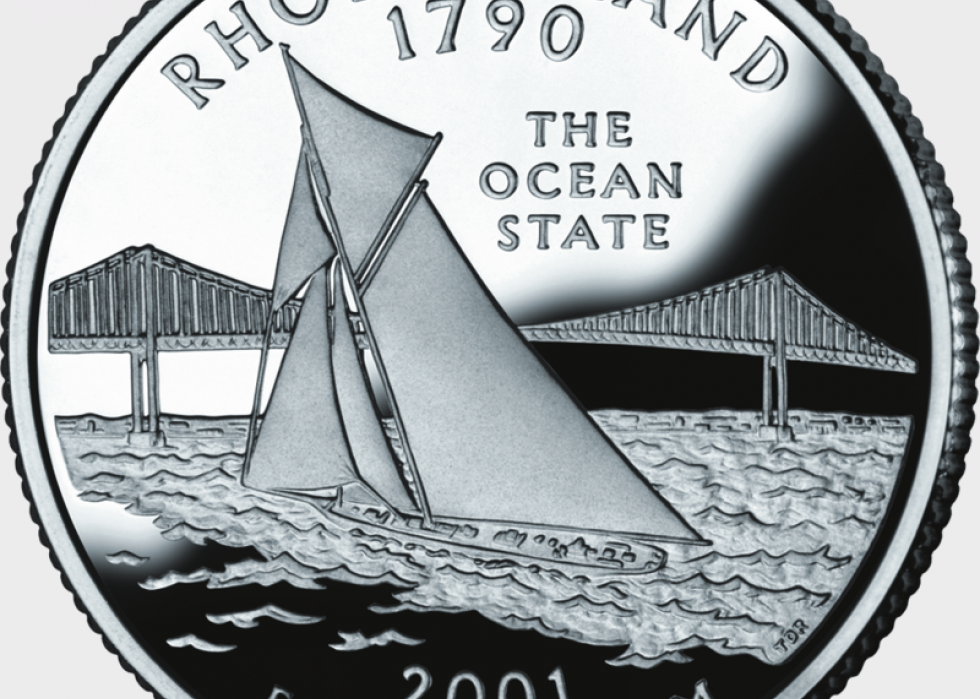
Rhode Island
Release date: May 21, 2001
Engraver: Thomas D. Rogers
Mintage: 870,100,000
This coin features an image of a vintage sailboat gliding through Rhode Island's famous Narragansett Bay, as well as an image of the Pell Bridge and "The Ocean State" inscribed.
The state has more than 400 miles of coastline and is known as the sailing capital of the world. Rhode Island residents chose the sailboat from three candidate designs during two weeks of voting at libraries, the State House and on the internet, by 57% of the 34,566 votes cast.
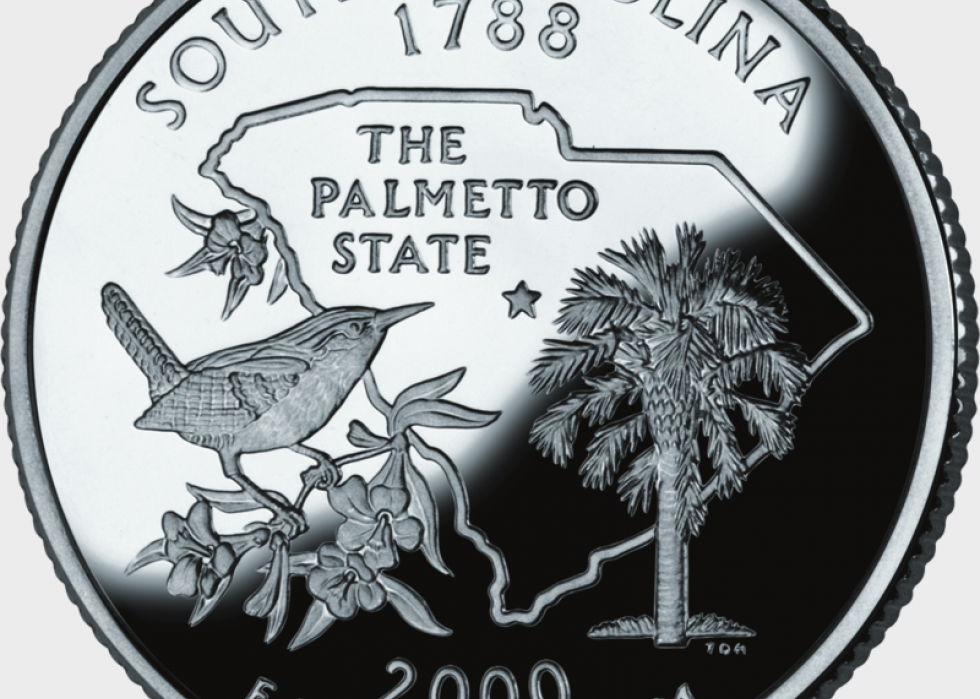
South Carolina
Release date: May 22, 2000
Engraver: Thomas D. Rogers
Mintage: 1,308,784,000
The coin shows the outline of the state and three symbols: a palmetto tree, the Carolina Wren, and the Yellow Jessamine, along with an inscription of its nickname "The Palmetto State" and a star that indicates the state's capital: Columbia.
The palmetto tree is also on the state's flag and seal. Its wood helped defeat the British at the Battle of Sullivan's Island by absorbing the shock of the cannonballs. Many of the ideas for the South Carolina quarter design came from elementary students.
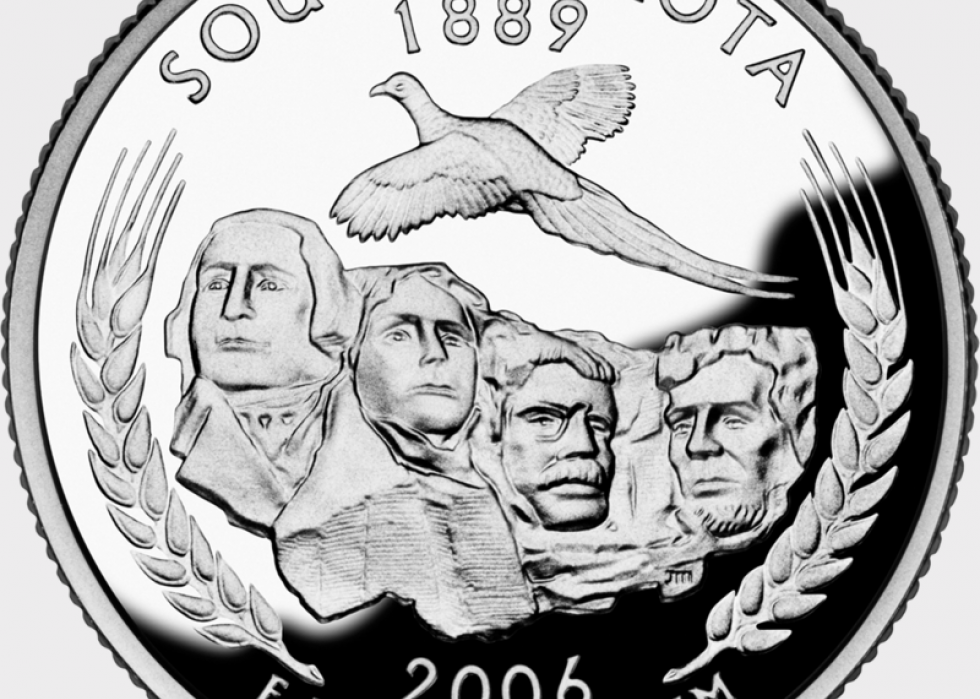
South Dakota
Release date: Nov. 6, 2006
Engraver: John Mercanti
Mintage: 510,800,000
Images on the South Dakota state quarter include the state bird, the Chinese ring-necked pheasant, Mount Rushmore National Memorial, and stalks of wheat—a major crop in the state.
Mount Rushmore displays the busts of four American presidents—George Washington, Thomas Jefferson, Theodore Roosevelt, and Abraham Lincoln, and took 14 years to create. Citizens voted online and at banks and credit unions, choosing this design over four others with a combination of the three symbols ultimately used, alongside a bison.
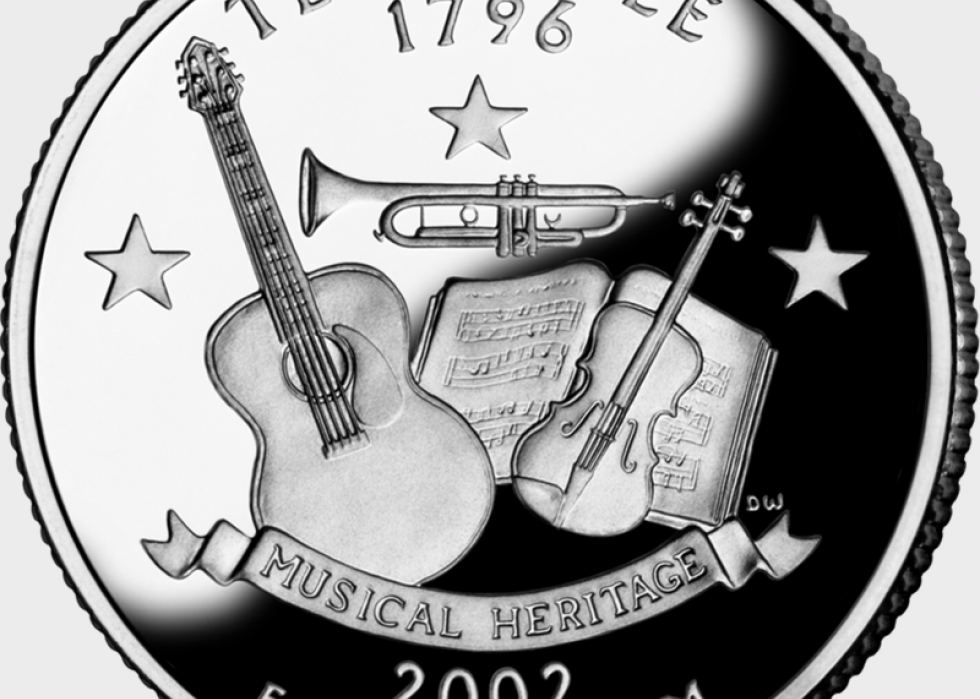
Tennessee
Release date: Jan. 1, 2002
Engraver: Donna Weaver
Mintage: 648,068,000
This coin depicts a fiddle, trumpet, and guitar. It also has a banner with the inscription "Musical Heritage," and three stars that represent the three regions of the state.
The three instruments have a hidden meaning: The fiddle stands for the bluegrass music of the mountains of east Tennessee, the guitar stands for the country music of central Tennessee where Nashville is, and the trumpet stands for the blues of west Tennessee and the city of Memphis. The Tennessee Coin Commission reviewed more than 1,000 design suggestions from across the state before choosing this one, submitted by an elementary school teacher.
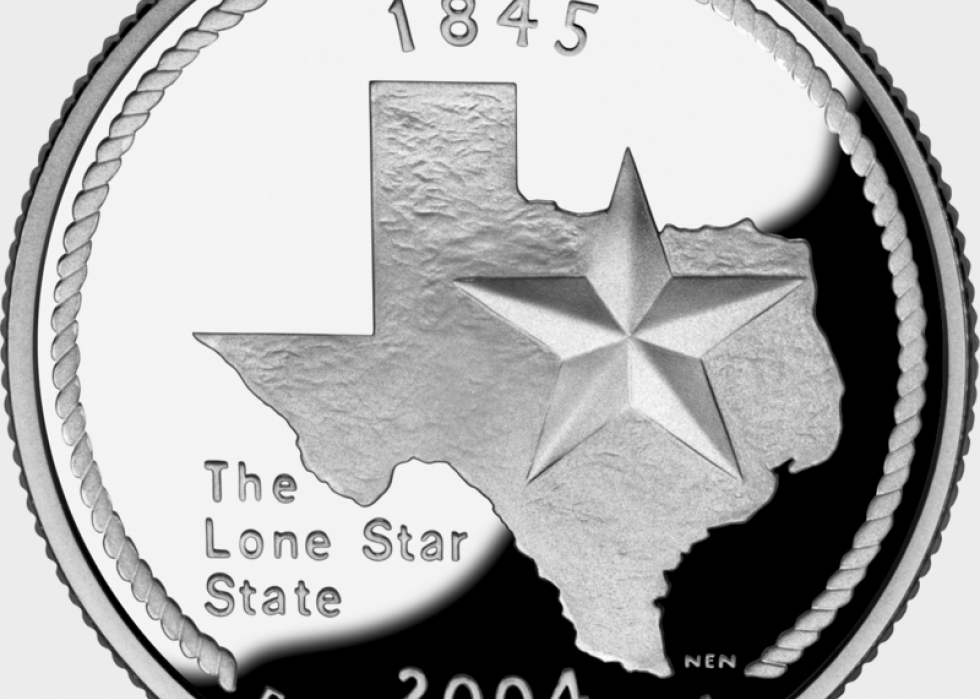
Texas
Release date: June 1, 2004
Engraver: Norman E. Nemeth
Mintage: 541,800,000
The quarter shows an outline of the state with a star superimposed on it, and the inscription "The Lone Star State." The lariat that encircles the design is symbolic of the cattle and cowboy history of Texas, as well as the frontier spirit that tamed the land. Nearly 2,600 candidate design concepts were submitted in response to a statewide contest.
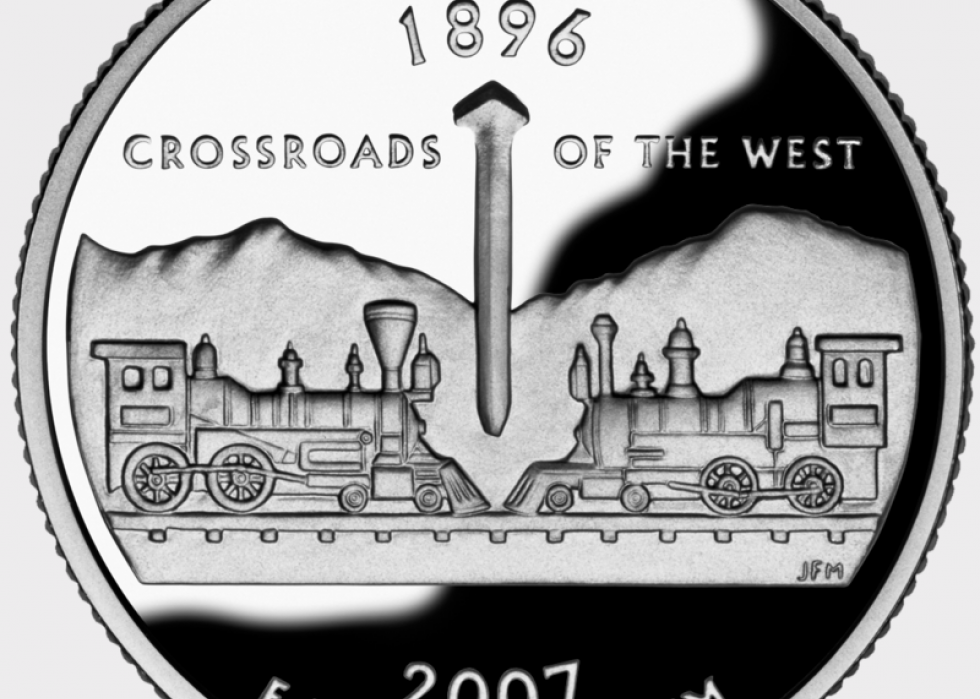
Utah
Release date: Nov. 5, 2007
Engraver: Joseph F. Menna
Mintage: 508,200,000
This coin shows two locomotives moving toward the golden spike that joined the Central Pacific and Union Pacific railroads, a union which took place in 1869. The inscription reads "Crossroads of the West."
The track made it possible for people to cross North America by rail. Linking the East to the West by train changed the Utah economy from farming to industry, and earned Utah its nickname. This design beat out other finalists, including the beehive part of the state seal, and a design to celebrate Utah's role as host of the 2002 Winter Olympics.
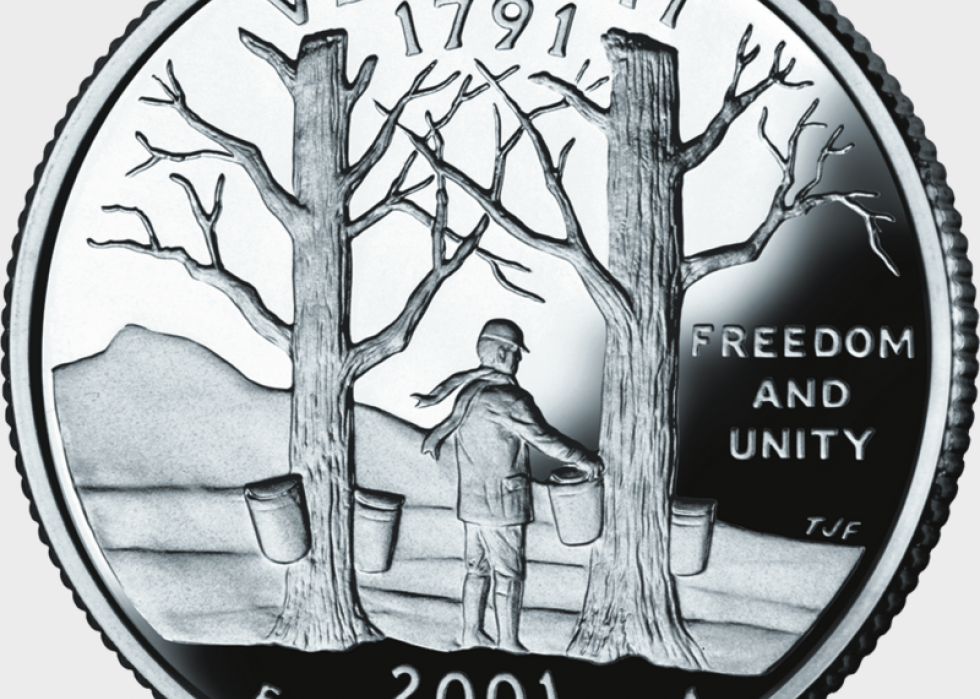
Vermont
Release date: Aug. 6, 2001
Engraver: T. James Ferrell
Mintage: 882,804,000
The image highlights one of Vermont's most significant landmarks: Camel's Hump Mountain. It also depicts maple trees collecting sap, along with the state's motto: "Freedom and Unity." The final design came from an 18-month process led by the Vermont Arts Council. The governor in turn asked citizens of Vermont for their opinions during public appearances around the state before choosing.
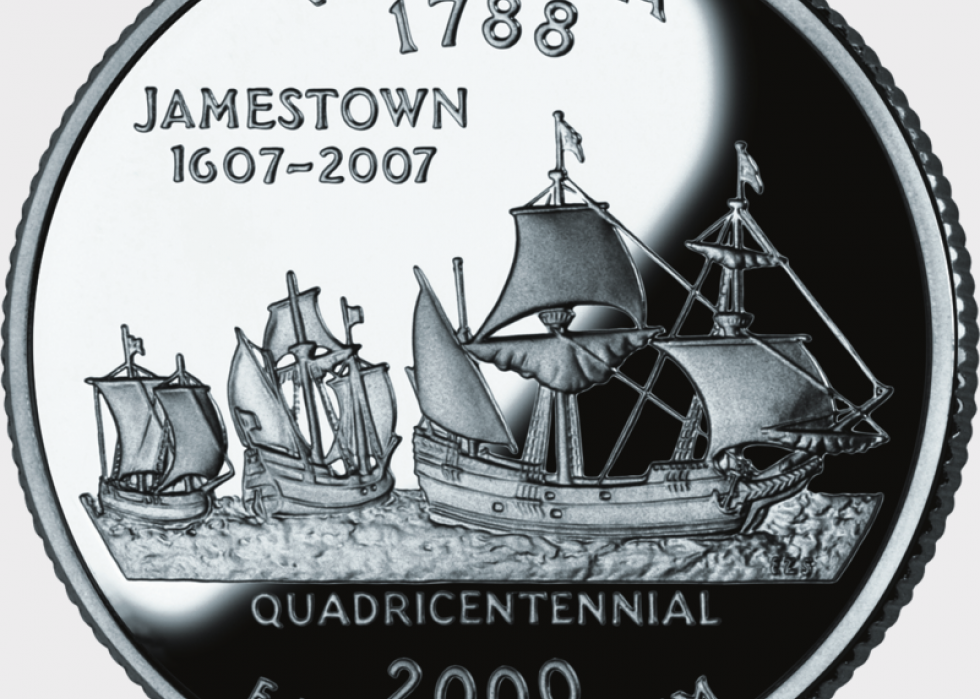
Virginia
Release date: Oct. 16, 2000
Engraver: Edgar Z. Steever
Mintage: 1,594,616,000
This coin includes images of Susan Constant, Godspeed, and Discovery: the three ships that brought the first English settlers to Jamestown. The inscription reads "Jamestown 1607–2007."
Jamestown is the nation's oldest colony and the first permanent settlement in the New World. The design was created through a collaborative effort from the state treasurer, representatives from the Library of Virginia, the Department of Historic Resources, the Virginia Tourism Corporation, and the Department of General Services.
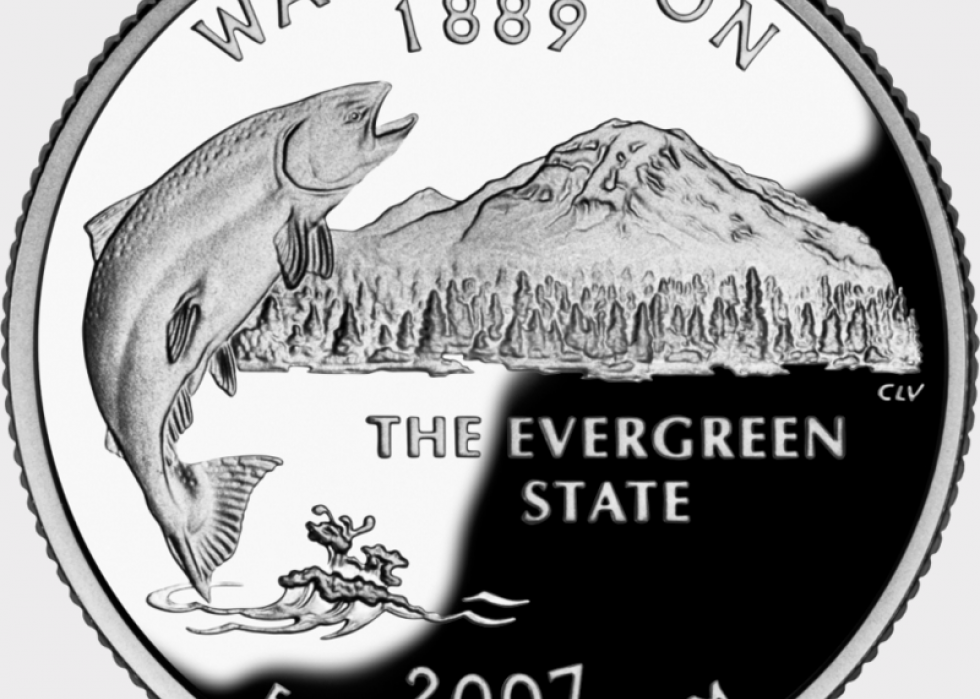
Washington
Release date: April 2, 2007
Engraver: Charles L. Vickers
Mintage: 545,200,000
The theme and inscription of this coin: "The Evergreen State." Depicted on the coin is an image of a salmon breaching the water in front of Mount Rainier. The salmon is essential to the diets of those in the Pacific Northwest, and Mount Rainier is part of the Cascade Range that passes through the state. It's a volcano covered by snow and glaciers, connecting the eastern and western parts of the state. A journalist named Washington "The Evergreen State" owing to its abundant pine trees, and the name stuck.
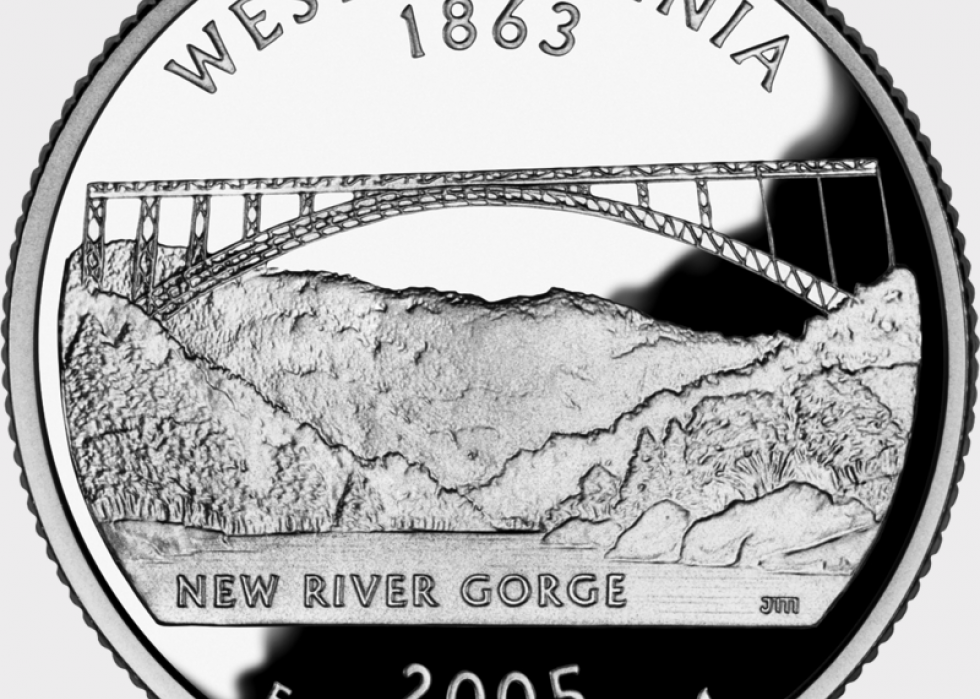
West Virginia
Release date: Oct. 14, 2005
Engraver: John Mercanti
Mintage: 721,600,000
West Virginia, admitted into the Union in 1863, features the New River and the New River Gorge Bridge on its quarter, with the inscription "New River Gorge." At 3,030 feet long, the New River Gorge Bridge is one of the world's longest steel spans, and the second-highest bridge in the United States, rising 876 feet above the gorge. About 1,800 design concepts were submitted from citizens across the state.
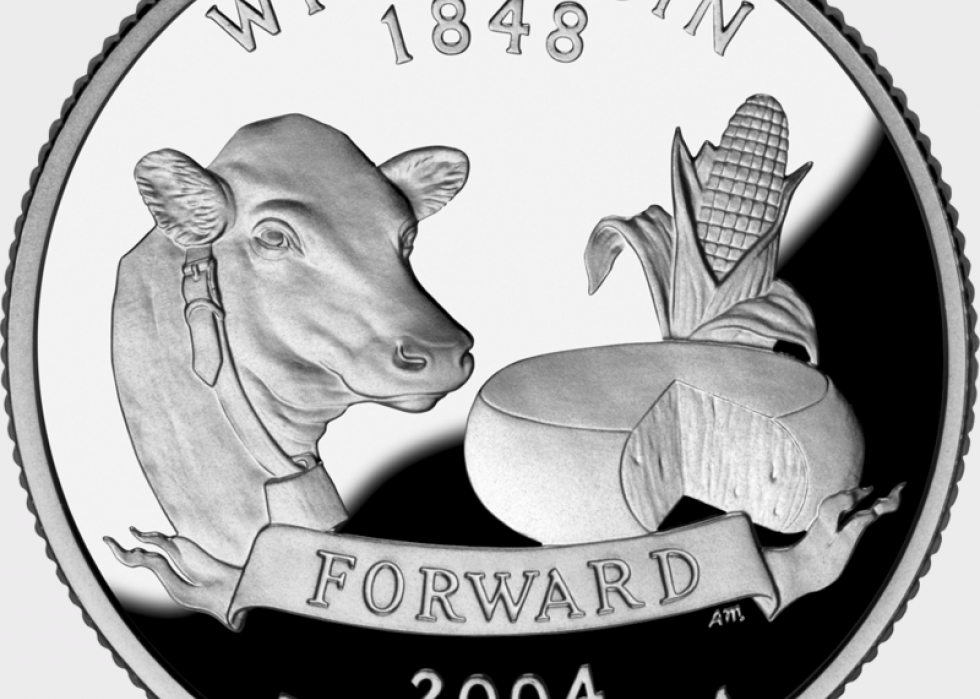
Wisconsin
Release date: Oct. 25, 2004
Engraver: Alfred Maletsky
Mintage: 453,200,000
The coin has an agricultural theme, featuring a cow, cheese, corn, and the inscription and state motto "Forward." More than a million cows live on Wisconsin's 17,000 dairy farms, and the state makes more than 350 different kinds of cheese. A statewide vote selected the "Agriculture/Dairy/Barns" theme over the other two candidates, "Scenic Wisconsin" and "Early Exploration and Cultural Interaction."
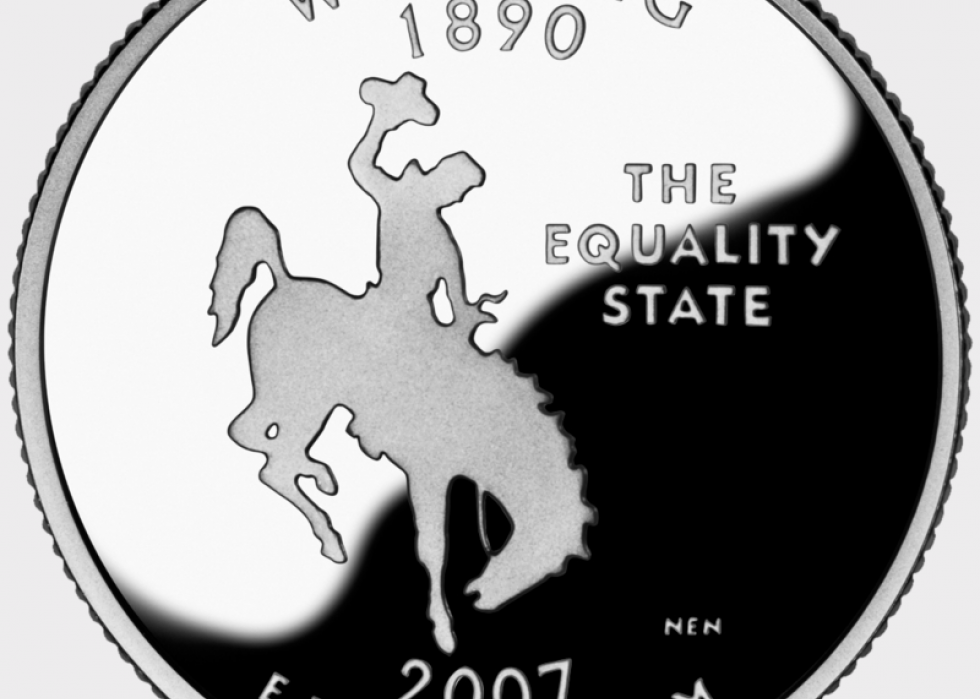
Wyoming
Release date: Sept. 3, 2007
Engraver: Norman E. Nemeth
Mintage: 564,400,000
The quarter displays an image of a bucking horse and rider, along with the inscription "The Equality State." The horse and rider symbolize Wyoming's Wild West heritage, with three of the five final designs for Wyoming featuring this image. Wyoming was nicknamed the "Equality State" because of its role in granting full voting rights to women, the first state to do so in 1869.



